With over 300 species to choose from, it’s hard to narrow down a collection of aloe! Historically, aloe vera has been used to treat burns, minor wounds, and a great deal of sunburn.

Not all aloe are made the same, however. Some species are more toxic than others since they contain compounds that can cause kidney failure, vomiting, and more.
To be safe with this genus, only Aloe barbadensis should ever be considered for use!
Jump to:
- 1. Aloe vera
- 2. Aloe Purple People Eater
- 3. Aloe polyphylla
- 4. Golden Toothed Aloe, Variegated
- 5. Aloe nobilis
- 6. Quiver Tree - Aloe dichotoma
- 7. Aloe ferox
- 8. Aloe ciliaris
- 9. Aloe castilloniae
- 10. Aloe Blue Elf
- 11. Aloe microstigma
- 12. Aloe striata
- 13. Aloe erinacea
- 14. Aloe divaricata
- 15. Aloe megalacantha
- 16. Aloe suzannae
- 17. Aloe ‘Christmas Carol’
- 18. Aloe humilis
- 19. Aloe haworthioides
- 20. Aloe cameronii
- 21. Aloe reitzii
- 22. Aloe buhrii
- 23. Aloe ‘Hercules’
- 24. Aloe aristata
1. Aloe vera
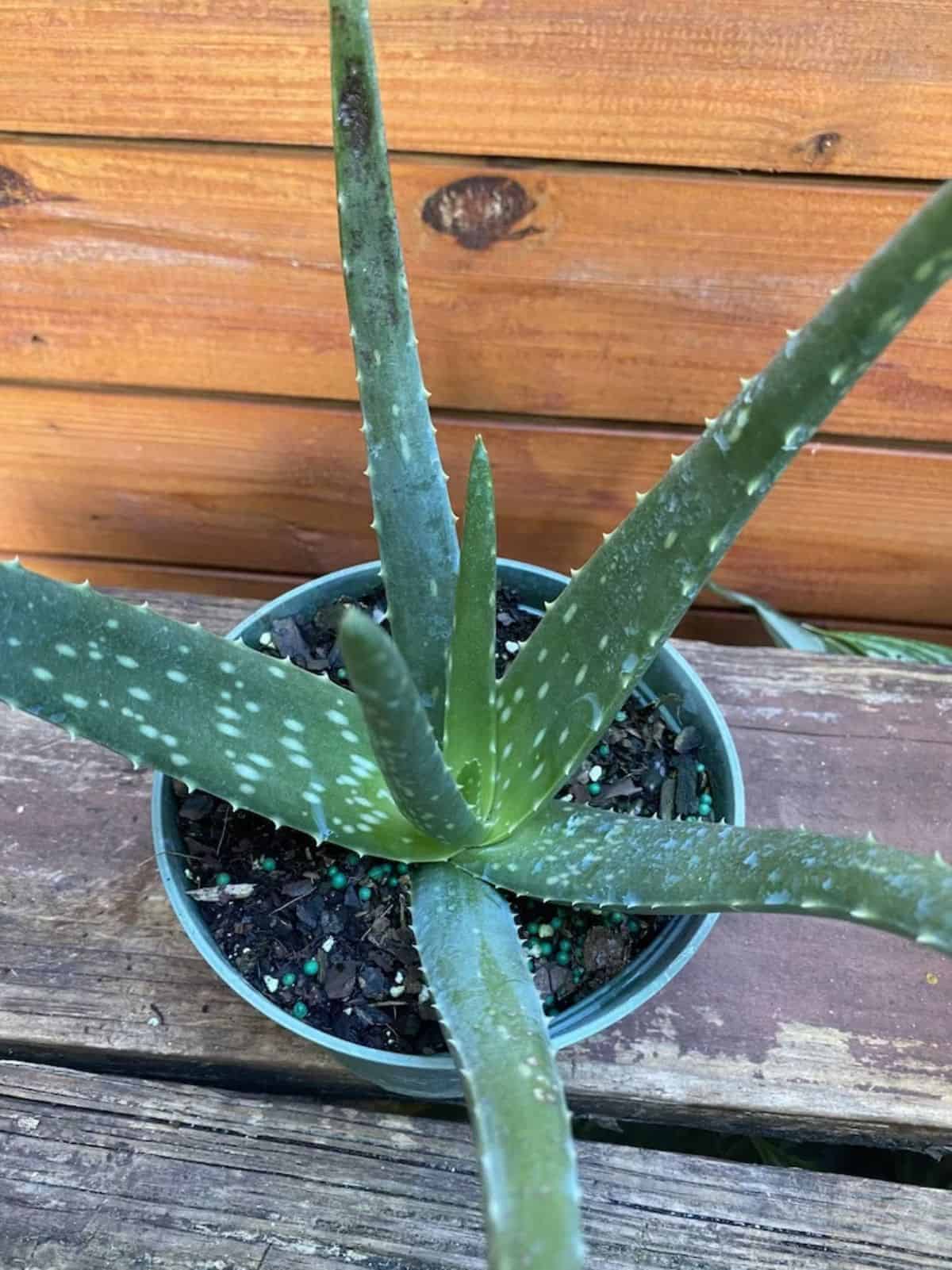
Buy it from:
| Maximum Height: | Up to 2 feet |
| Maximum Width: | Yellow and Tubular on 3-foot racemes |
| Watering Needs: | Weekly in dry areas, bi-weekly in most other environments |
| Soil Needs: | Gritty soil mix |
| Light Needs: | Full sun, watch for sunburn (leaves turning brown/wilting) |
| Hardiness Zone(s): | Zone 10 and up |
| Leaf Type: | Light green and triangular |
| Bloom Type: | Yellow and Tubular on 3-foot racemes |
| Growth Type: | Easily forms clumps: will take over if not potted or managed. |
Aloe barbadensis, also known as medicinal aloe, is characterized by triangular tapering leaves with white spots. It is one of the more sensitive species when it comes to sun exposure; however, it is often kept close at hand at many a home. There are many preparations needed to make aloe barbadensis edible; however, stripping the leaves of their green skin and using the jelly inside to help with skin irritations is one of the safest ways to use this species.
2. Aloe Purple People Eater
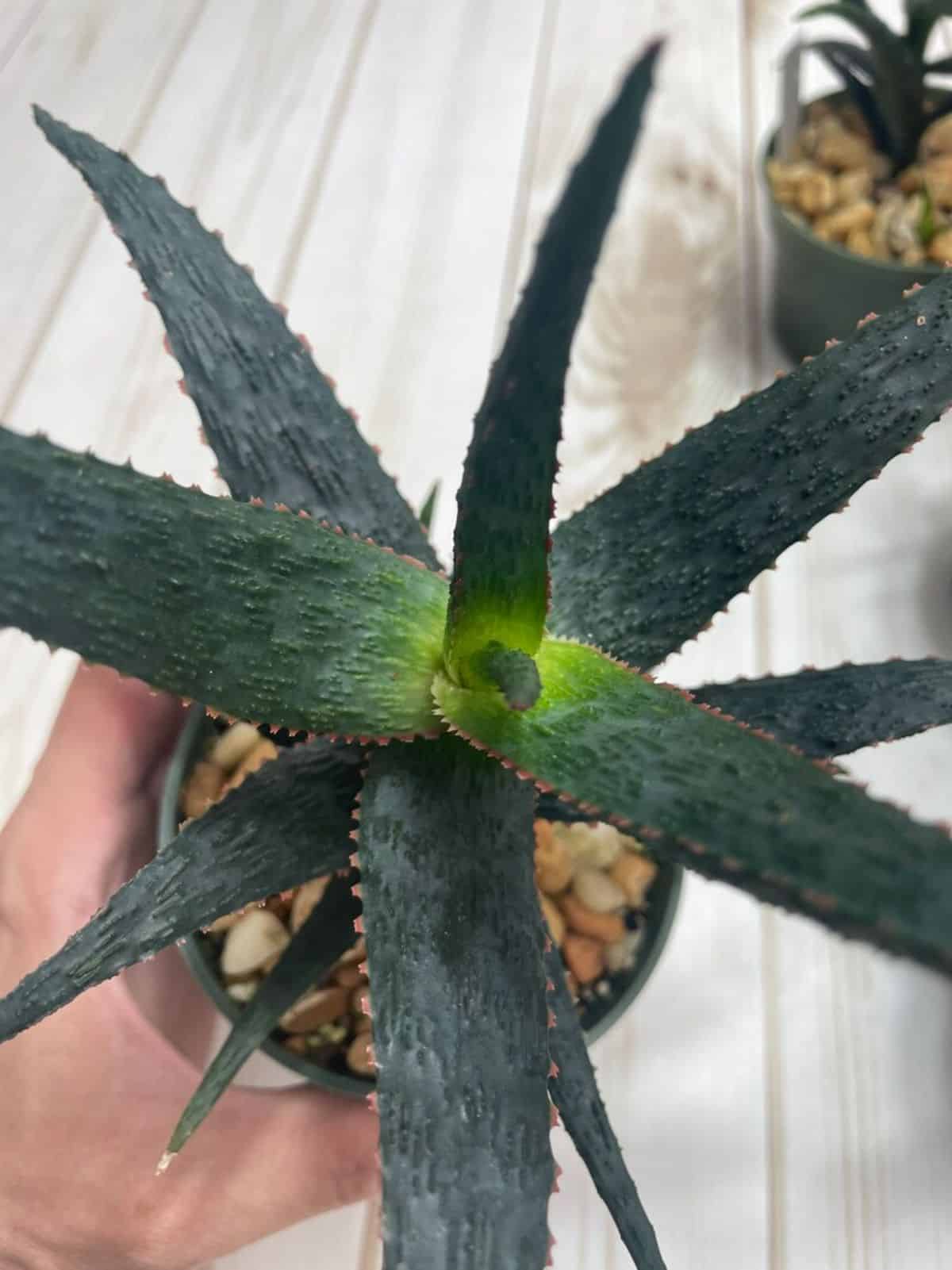
Buy it from:
| Maximum Height: | Up to 10 inches |
| Maximum Width: | Up to 8 inches |
| Watering Needs: | Weekly in dry areas, bi-weekly in most other environments |
| Soil Needs: | Gritty soil mix |
| Light Needs: | Full sun, watch for sunburn (leaves turning brown/wilting) |
| Hardiness Zone(s): | Zone 6 and up |
| Leaf Type: | Triangular with lavender leaves, red margins, and red tubercles. |
| Bloom Type: | Racemes up to 14 inches tall with tubular flowers that are red along the outside and yellow on the inside. |
| Growth Type: | Will form clumps of up to 30 rosettes |
Officially, the breeding of this species began back in July 2017. What sets it apart is that this species can have a lighter lavender color that darkens when exposed to more sunlight. It could easily be mistaken for other types of red-toothed aloe; however, the combination of lighter purple with red will always set the Purple People Eater apart.
3. Aloe polyphylla
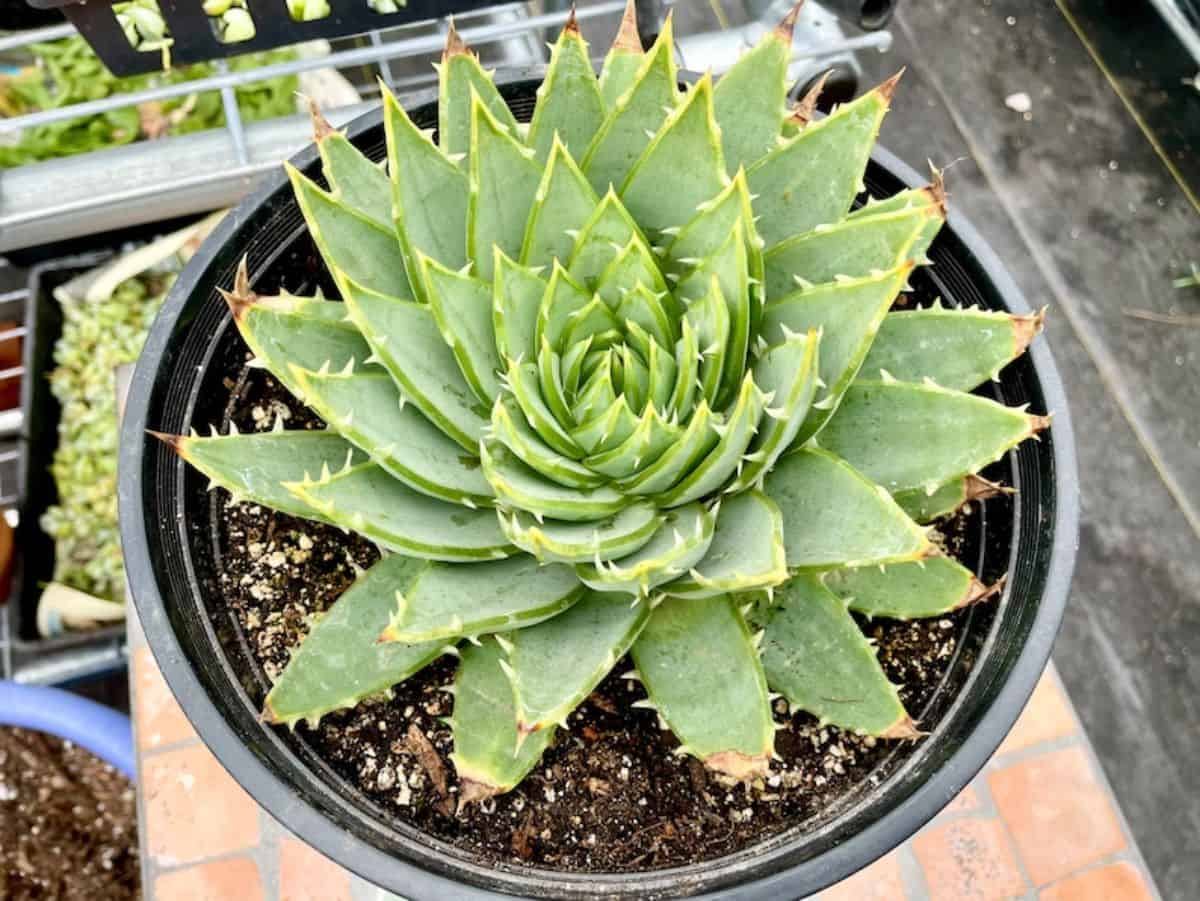
Buy it from:
| Maximum Height: | Up to 1 foot |
| Maximum Width: | Up to 2 feet |
| Watering Needs: | Weekly in dry areas, bi-weekly in most other environments |
| Soil Needs: | Gritty soil mix |
| Light Needs: | Full sun, watch for sunburn (leaves turning brown/wilting) |
| Hardiness Zone(s): | Zone 9 and up |
| Leaf Type: | Triangular with light green teeth and orange terminal spines |
| Bloom Type: | Salmon tubular blooms |
| Growth Type: | Counterclockwise or clockwise spiral on a singular rosette |
Probably one of the most intriguing species of aloe, A. polyphylla is known as the Spiral Aloe. It is the only of its kind that grows in a spiral from the center of the rosette. This species does not have a specific twist, such as only growing clockwise, and will swirl in multiple directions. It is not easily propagated unless you are lucky enough to see a rare pup!
4. Golden Toothed Aloe, Variegated
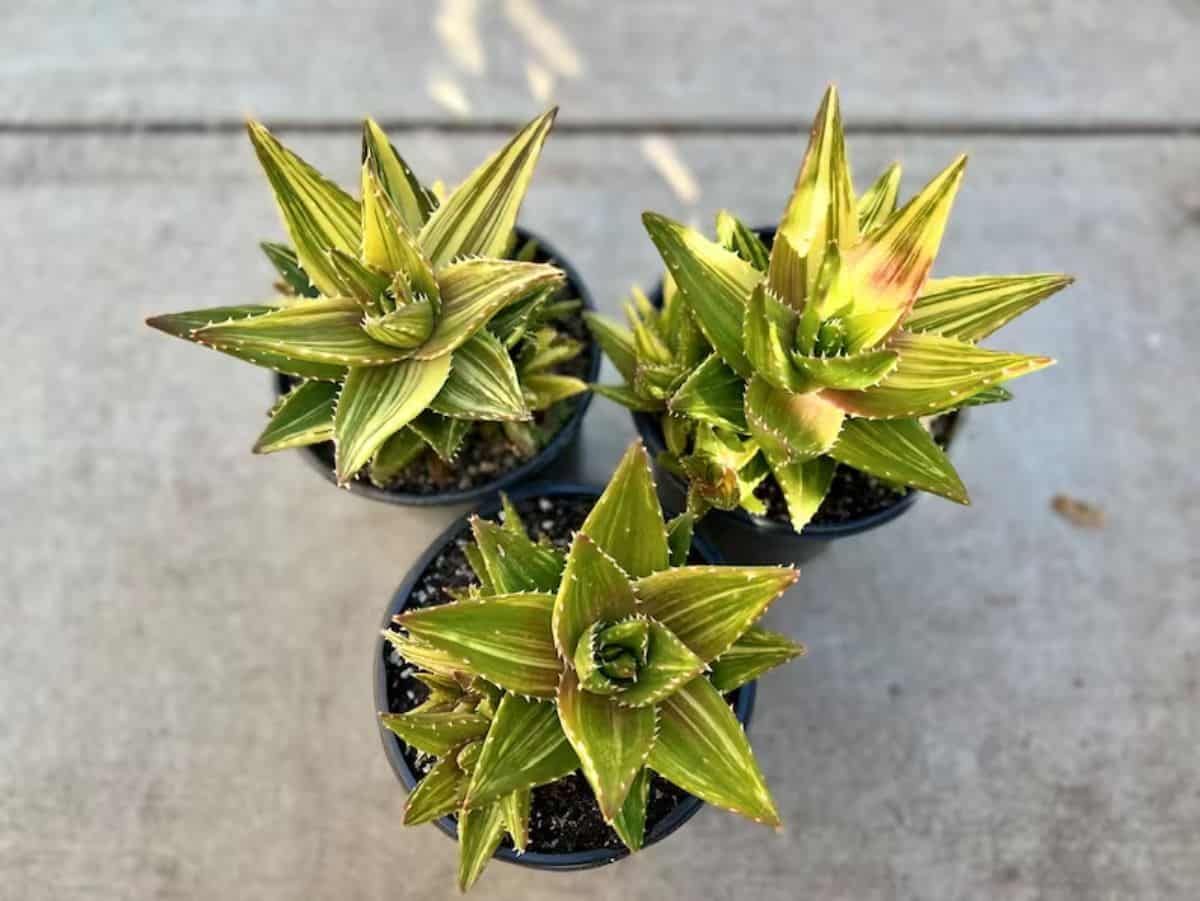
Buy it from:
| Maximum Height: | Up to 18 inches |
| Maximum Width: | Up to 10 inches |
| Watering Needs: | Weekly in dry areas, bi-weekly in most other environments |
| Soil Needs: | Gritty soil mix |
| Light Needs: | Full sun, watch for sunburn (leaves turning brown/wilting) |
| Hardiness Zone(s): | Zone 9 and up |
| Leaf Type: | Thing triangles with green and yellow variegation; white teeth are present along the margins |
| Bloom Type: | Tubular and orange |
| Growth Type: | Produces offsets |
Aloe nobilis variegata is an impressive species with vertical yellow variegation. Like the non-variegated parent species, it also has teeth that can appear golden with quick and easy offsets. This species can take up a lot of space quickly. Generally speaking, A.nobilis variegata can grow larger than the original species!
5. Aloe nobilis
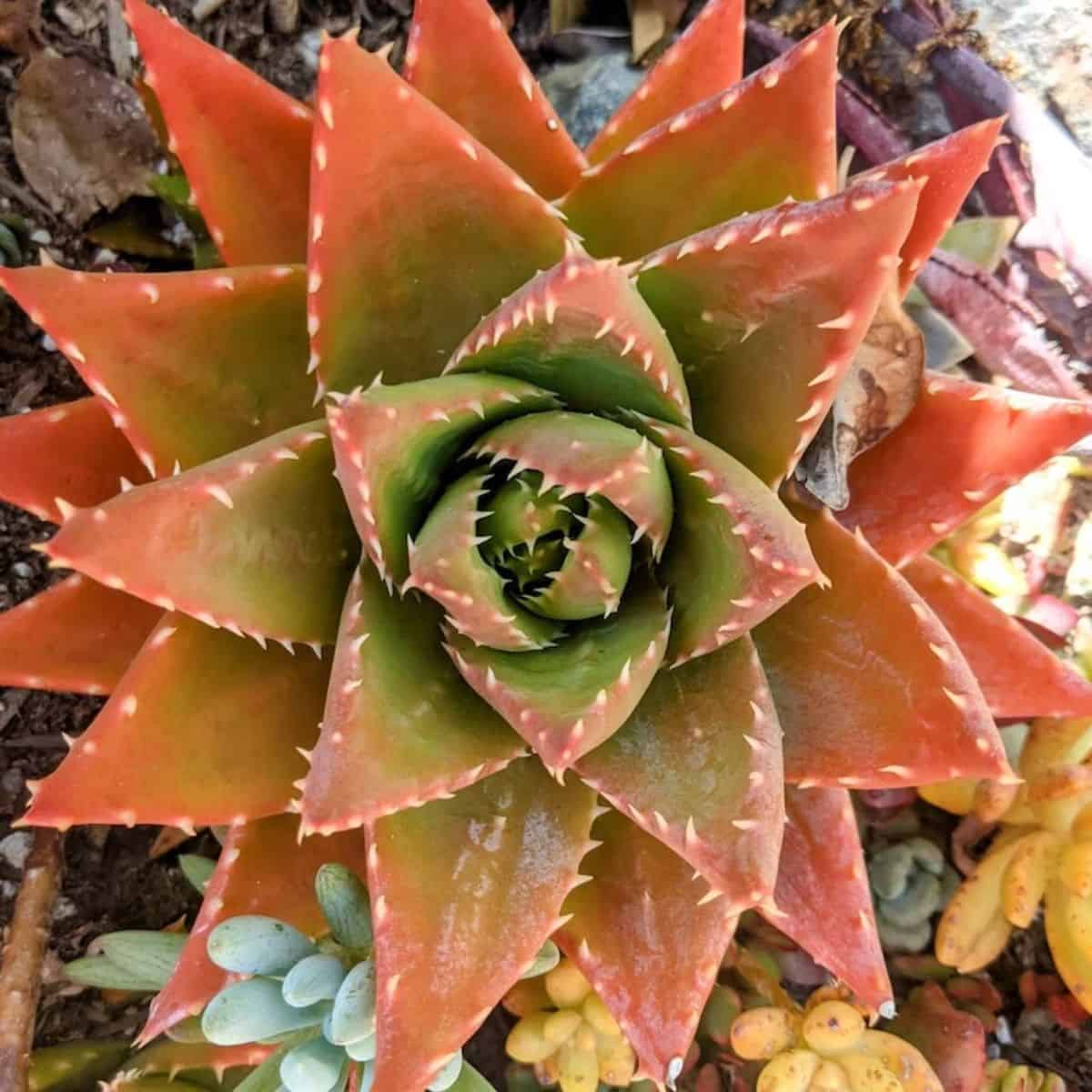
Buy it from:
| Maximum Height: | Up to 1 foot |
| Maximum Width: | Up to 1 foot |
| Watering Needs: | Weekly in dry areas, bi-weekly in most other environments |
| Soil Needs: | Gritty soil mix |
| Light Needs: | Full sun, watch for sunburn (leaves turning brown/wilting) |
| Hardiness Zone(s): | Zone 9 and up |
| Leaf Type: | Triangular with a wider base; light green with yellow-white teeth. |
| Bloom Type: | Tubular, bright orange, and on a 2-foot tall blooming spike |
| Growth Type: | Forms very large colonies if not managed (akin to groundcover) |
As a compact species with the capability of becoming ground cover, the Golden Toothed Aloe (non-variegated) is a special species with very attractive foliage. Each rosette has a maximum height of one foot; however, because of how the rosettes can grow off of one another, some may appear taller. One of the most attractive elements is the way that the tall blooming stalks create a carpet of bright orange flowers when a colony has been allowed to grow.
6. Quiver Tree - Aloe dichotoma
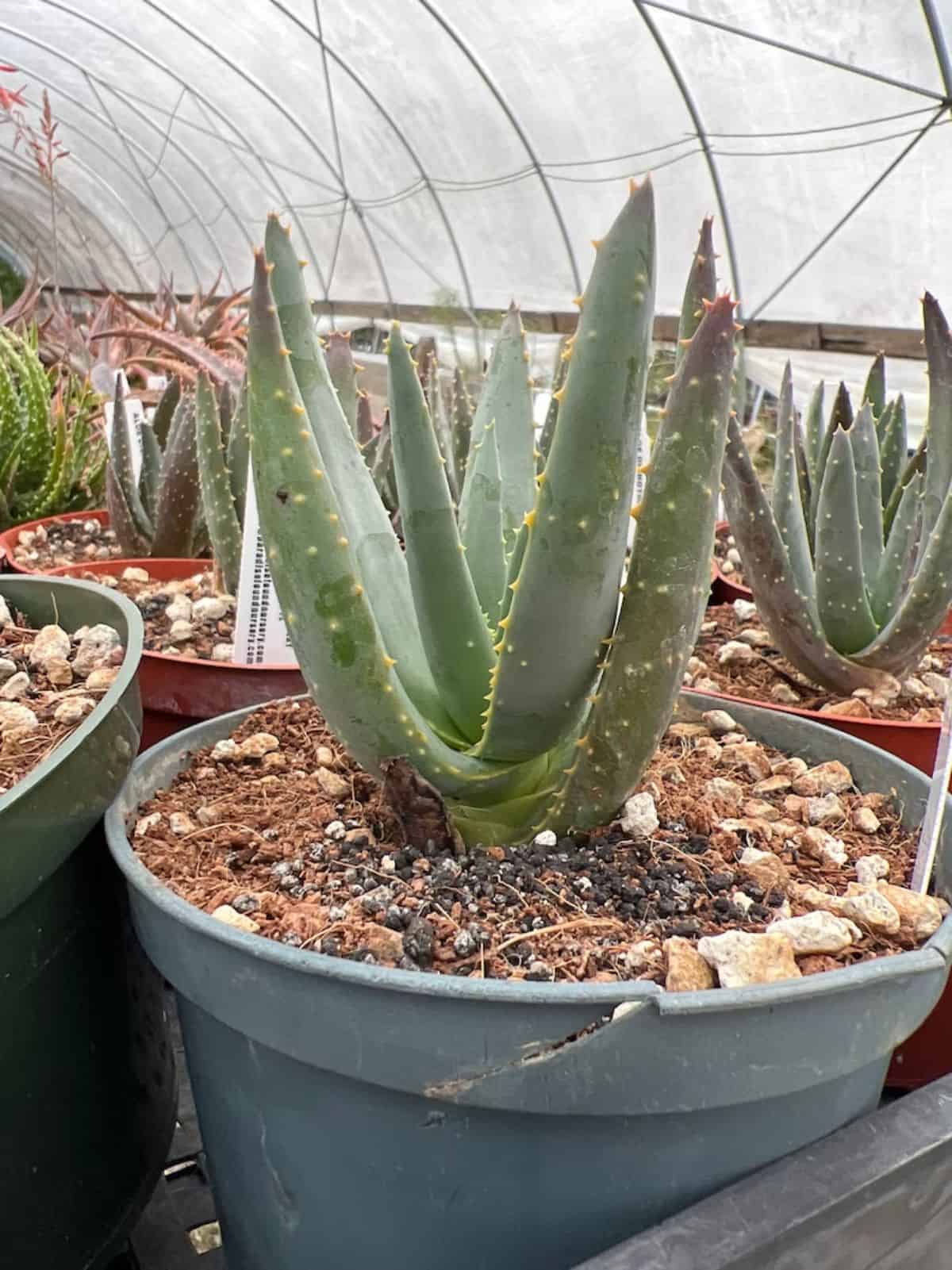
Buy it from:
| Maximum Height: | 12-inch blooming stalk with striking yellow, tubular blooms. Generally very heavy with nectar. |
| Maximum Width: | Trunk size can be over 3 feet |
| Watering Needs: | Weekly in dry areas, bi-weekly in most other environments |
| Soil Needs: | Gritty soil mix |
| Light Needs: | Full sun, watch for sunburn (leaves turning brown/wilting) |
| Hardiness Zone(s): | Zone 7 and up |
| Leaf Type: | Triangular and deep blue-green with brown margins and teeth |
| Bloom Type: | 12-inch blooming stalk with striking yellow, tubular blooms. Generally very heavy with nectar. |
| Growth Type: | Heavily forking tree with terminal rosettes, can get up to 80 years old. |
One of the most impressive tree-like species of aloe, the Quiver Tree is a desert staple with sharp bark that can easily cut you if not careful. The bright yellow flowers that grow from the center of each rosette are so heavy with nectar that birds, insects, and even baboons are attracted to the flowers: A. dichotoma is often stripped of its flowers out in the wild!
7. Aloe ferox
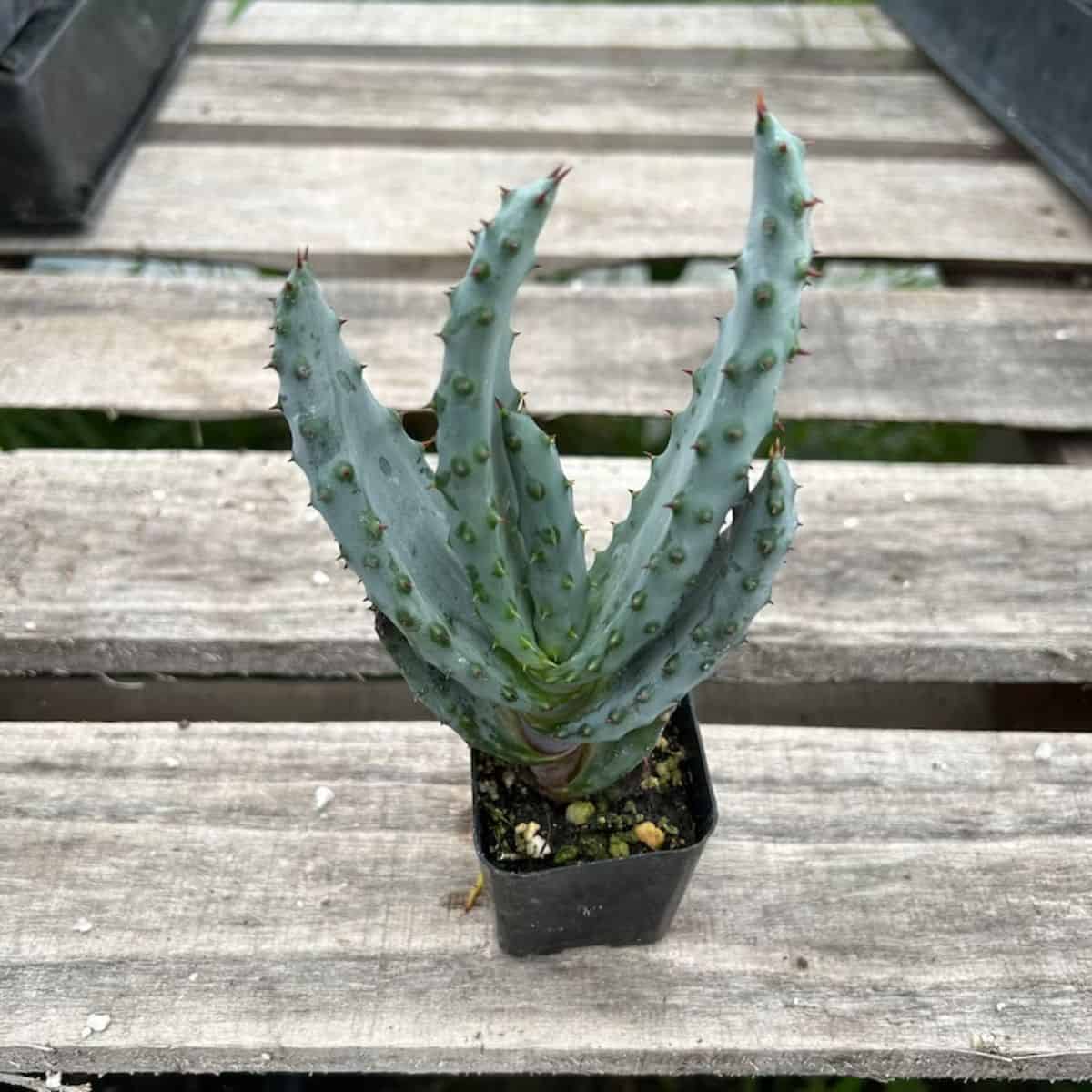
Buy it from:
| Maximum Height: | Up to 9 feet |
| Maximum Width: | Up to 5 feet |
| Watering Needs: | Weekly in dry areas, bi-weekly in most other environments |
| Soil Needs: | Gritty soil mix |
| Light Needs: | Full sun, watch for sunburn (leaves turning brown/wilting) |
| Hardiness Zone(s): | Zone 9 and up |
| Leaf Type: | Thick and triangular; light green with brownish-red margins and sharp teeth. |
| Bloom Type: | Candelabra-type red tubular flowers on blooming stems with several branches |
| Growth Type: | Single Stem |
Also known as Cape Aloe, or Bitter Aloe, this species is perhaps one of the most recognizable due to its size and flaming blooming spears. The silvery green leaves are very broad on adults, and the blooming stalks will branch profusely at the base. They create beautiful hedges and are often used as forms of defensive and spiny protection.
8. Aloe ciliaris
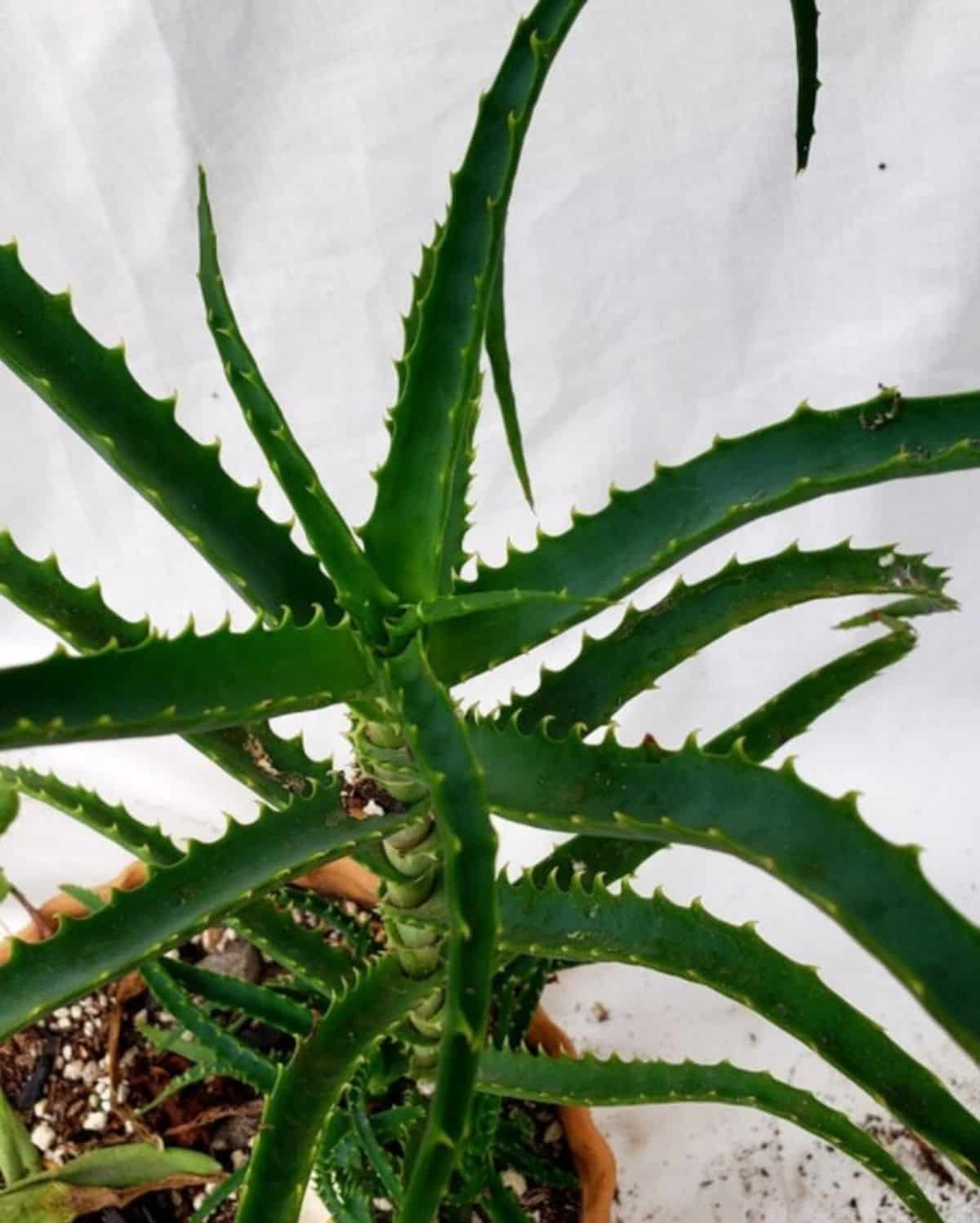
Buy it from:
| Maximum Height: | Up to 30 feet |
| Maximum Width: | Undetermined |
| Watering Needs: | Weekly in dry areas, bi-weekly in most other environments |
| Soil Needs: | Gritty soil mix |
| Light Needs: | Full sun, watch for sunburn (leaves turning brown/wilting) |
| Hardiness Zone(s): | Zone 9 and up |
| Leaf Type: | Thin and triangular with white teeth |
| Bloom Type: | Tubular and bright red-orange (will bloom year-round) |
| Growth Type: | Completely vertical growth on thin stems |
Climbing Aloe is one of the more interesting species things of its growing habit. Instead of growing into colonies, it creates more stems that grow upward and climb wherever they can! They will grow quickly if given the right care; however, they can also be encouraged to crawl rather than climb. That’s what I’ve done with mine.
9. Aloe castilloniae
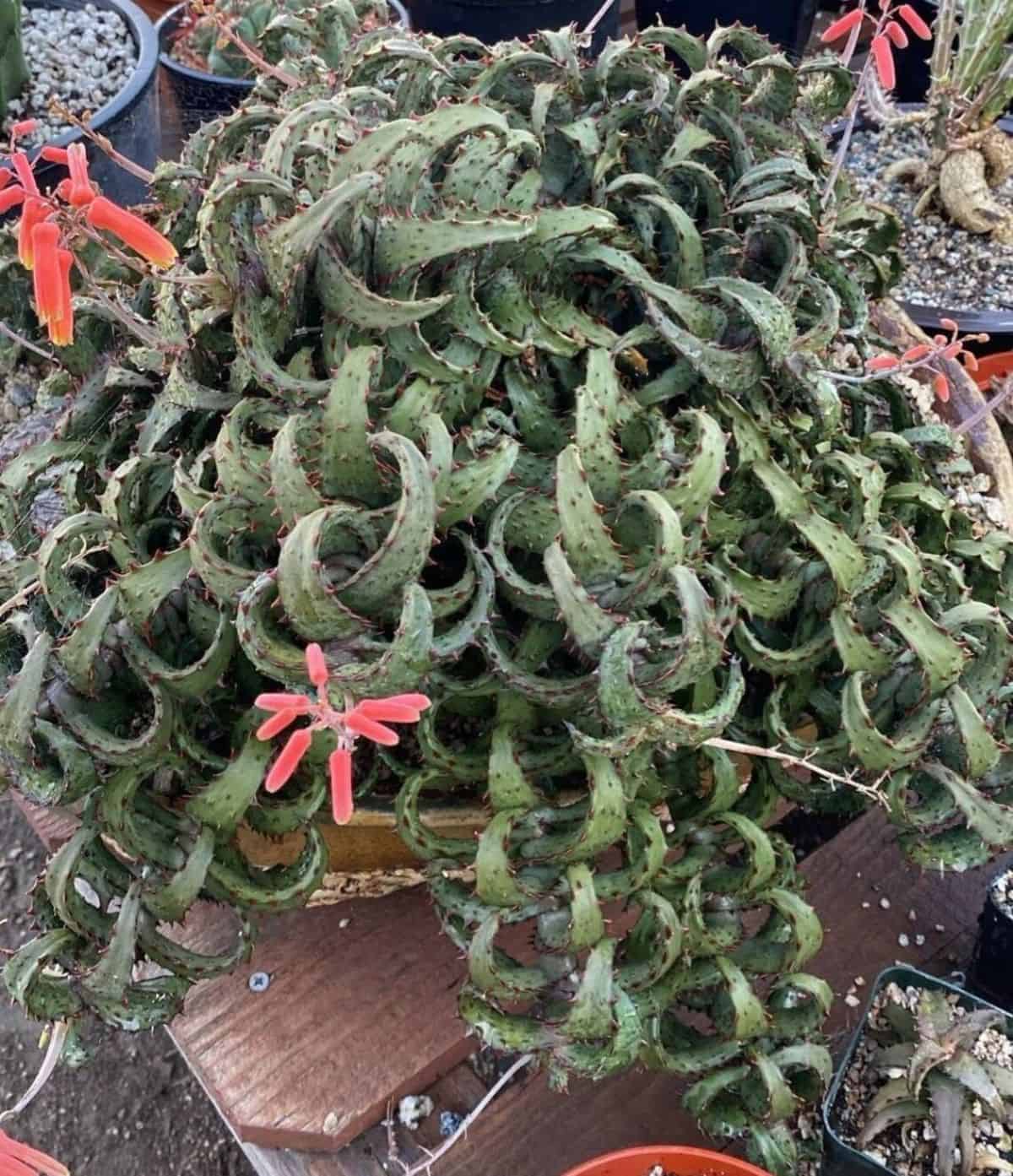
Buy it from:
| Maximum Height: | Up to 1 foot |
| Maximum Width: | Up to 3 feet |
| Watering Needs: | Weekly in dry areas, bi-weekly in most other environments |
| Soil Needs: | Gritty soil mix |
| Light Needs: | Full sun, watch for sunburn (leaves turning brown/wilting) |
| Hardiness Zone(s): | Zone 9 and up |
| Leaf Type: | Triangular with striking recurve, deep olive coloration with wide red teeth |
| Bloom Type: | Tubular with red on the outside of the flower and yellow within; blooming stalks are only 2 inches tall. |
| Growth Type: | Clustering |
This species tends to be more of a collector aloe from the hillsides of Madagascar. Most aloe don’t exhibit strong recurving leaves, but this species does. They look rather curly and are also very showy with a deep olive (at times purplish) leaf color contrasted by rusty red teeth and margins.
10. Aloe Blue Elf
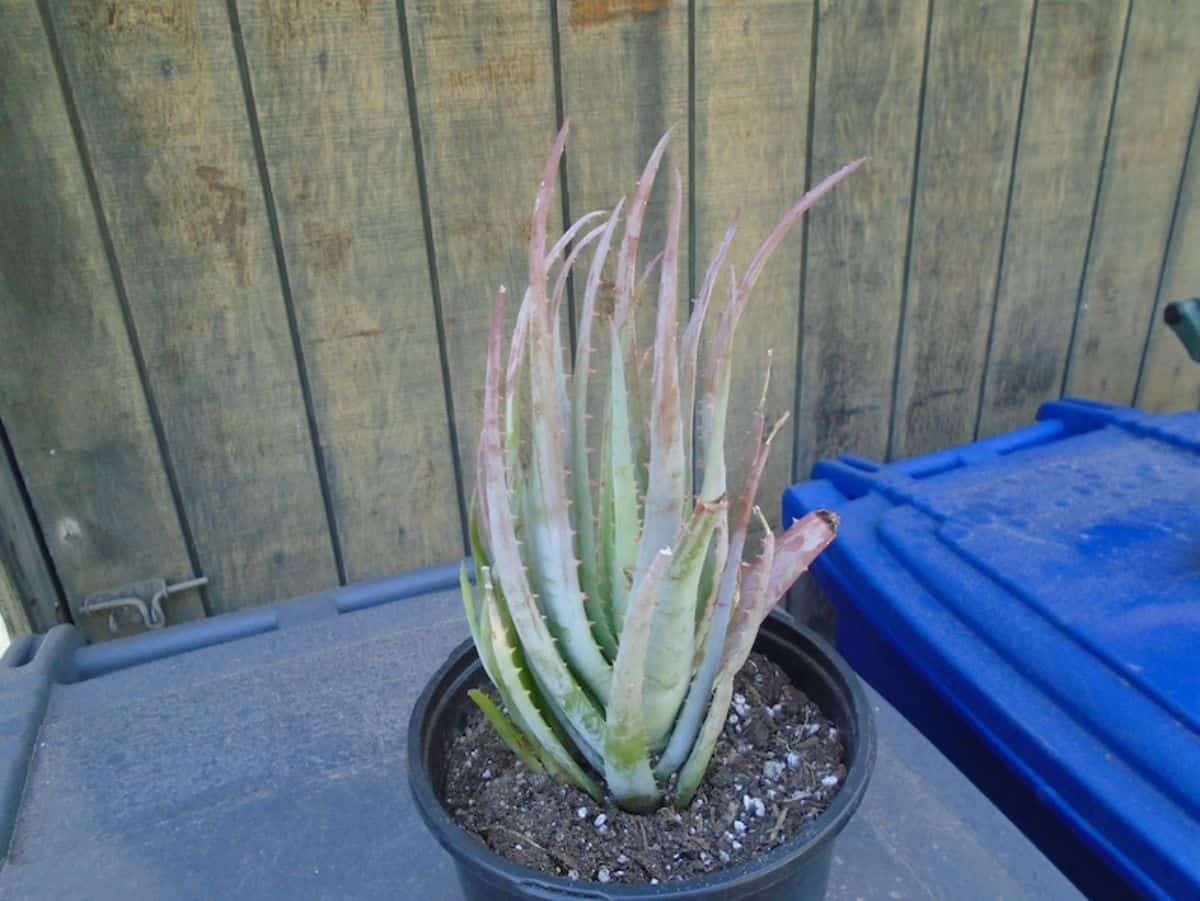
Buy it from:
| Maximum Height: | Up to 2 feet |
| Maximum Width: | Up to 2 feet |
| Watering Needs: | Weekly in dry areas, bi-weekly in most other environments |
| Soil Needs: | Gritty soil mix |
| Light Needs: | Full sun, watch for sunburn (leaves turning brown/wilting) |
| Hardiness Zone(s): | Zone 9 and up |
| Leaf Type: | Blue-green and elongated; triangular with widely spaced teeth |
| Bloom Type: | Tubular and red |
| Growth Type: | Clumps very quickly and will take over if not managed |
Blue Elf is reminiscent of elven ears that grow to thin pints. The teeth along the edges protect the plant, but the teeth are very widely spaced. These are constant bloomers and have very showy red flowers that contrast the pale blue-green leaves. This species does well in pots but can also be used as a filler as it easily colonizes an area.
11. Aloe microstigma
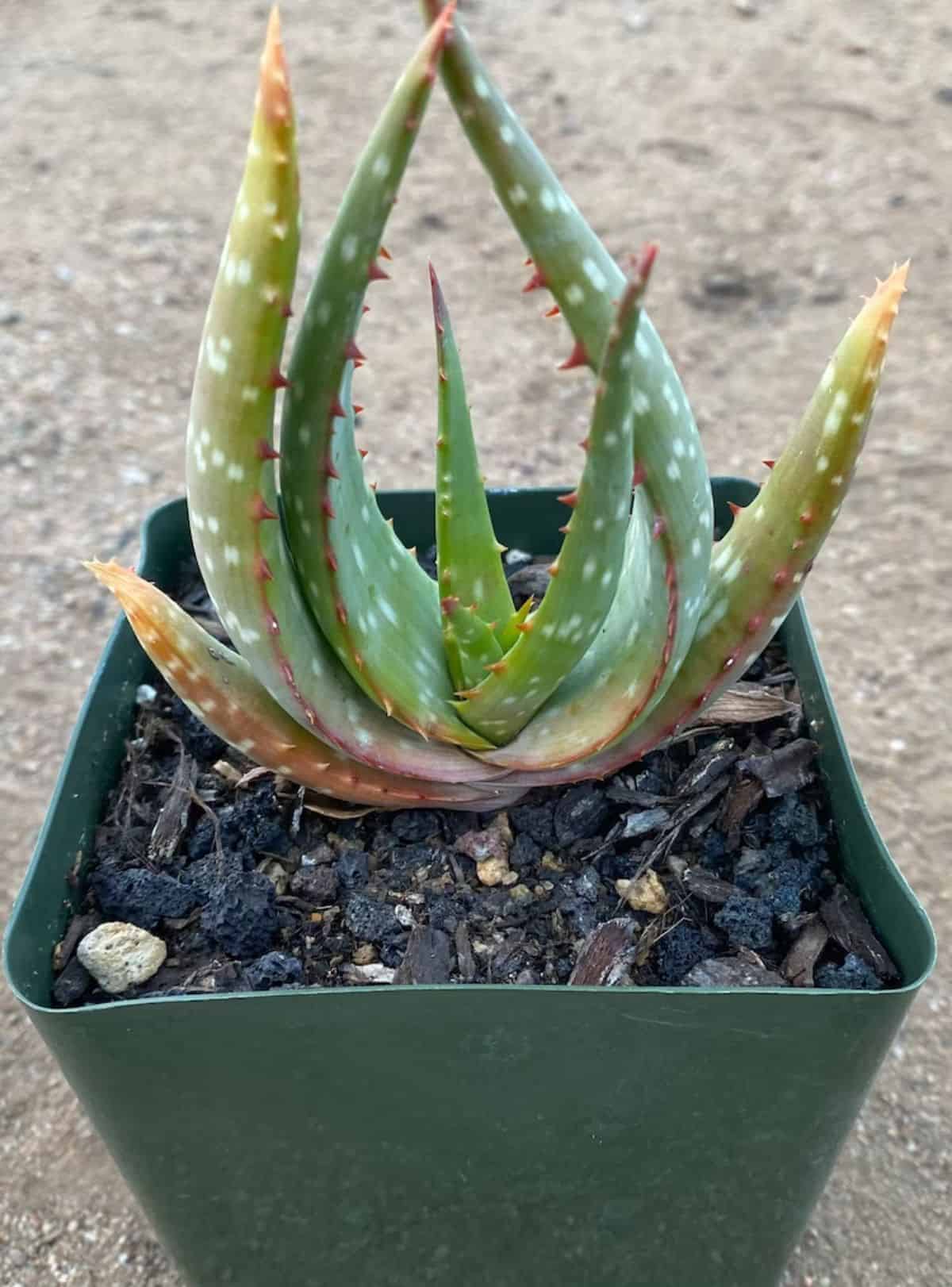
Buy it from:
| Maximum Height: | Up to 2 feet |
| Maximum Width: | Up to 2 feet |
| Watering Needs: | Weekly in dry areas, bi-weekly in most other environments |
| Soil Needs: | Gritty soil mix |
| Light Needs: | Full sun, watch for sunburn (leaves turning brown/wilting) |
| Hardiness Zone(s): | Zone 9 and up |
| Leaf Type: | Triangular with some curling; blue-green with red teeth and white spots. Will turn red and yellow when stressed. |
| Bloom Type: | Triangular with some curling; blue-green with red teeth and white spots. Will turn red and yellow when stressed. |
| Growth Type: | Can form clumps |
One of the more impressively colored species, Cape Speckled Aloe changes color based upon the stresses of the environment. Instead of recurving like A. castilloniae, the leaves of this species can curl inward slightly. When they are under too much stress, the speckled leaves will turn bright yellow and red. While it is attractive, extended periods of environmental stress will easily kill off any succulent!
12. Aloe striata
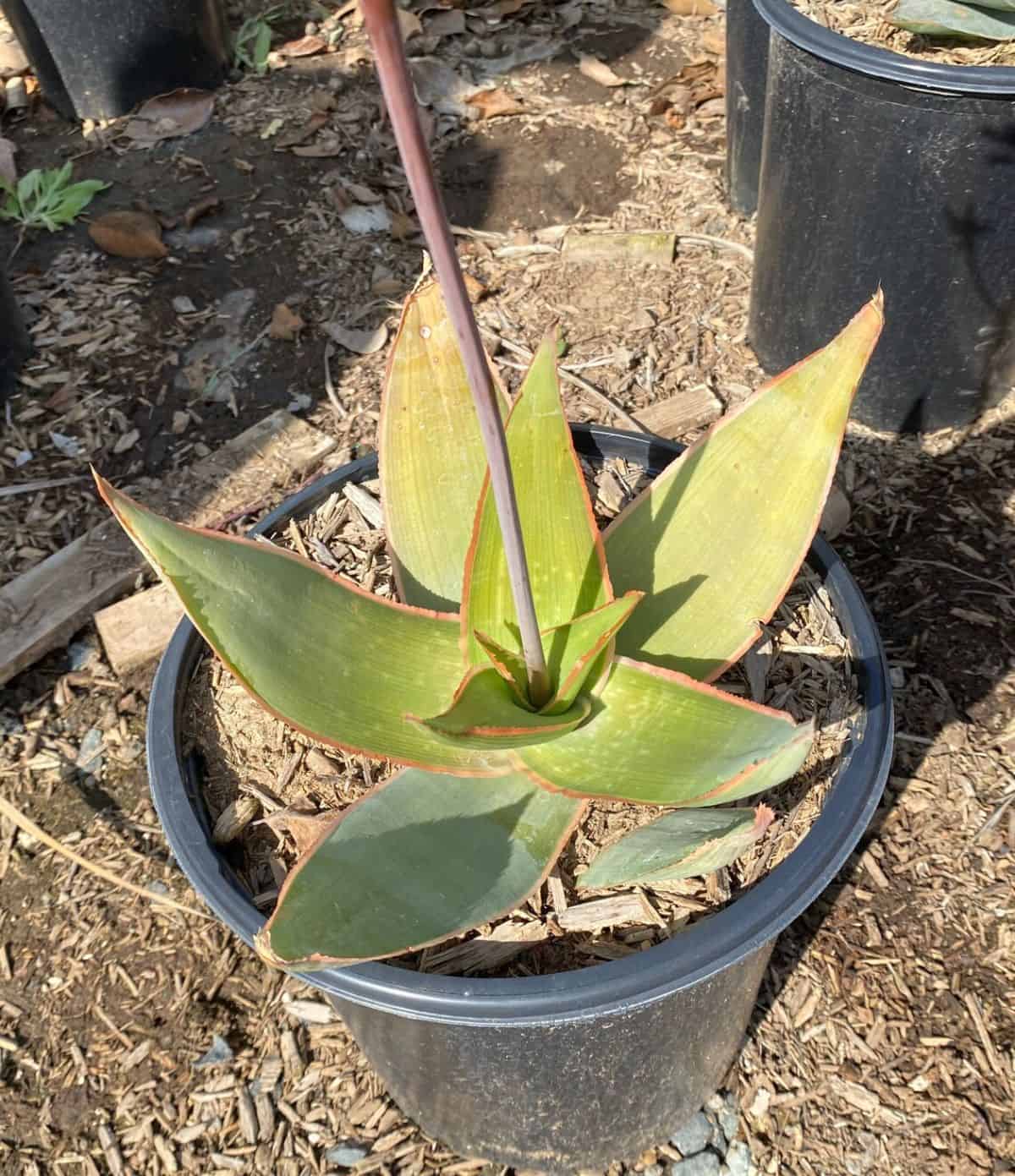
Buy it from:
| Maximum Height: | Up to 2 feet |
| Maximum Width: | Up to 3 feet |
| Watering Needs: | Weekly in dry areas, bi-weekly in most other environments |
| Soil Needs: | Gritty soil mix |
| Light Needs: | Full sun, watch for sunburn (leaves turning brown/wilting) |
| Hardiness Zone(s): | Zone 8 and up |
| Leaf Type: | Very Broad triangular leaves with red margins (no teeth) |
| Bloom Type: | Red tubular blooms |
| Growth Type: | Clumps and does not form offsets |
Coral aloe is an impressive specimen with very broad leaves that grow outward from the base of the rosette. The coloration is also hard to describe, as it is almost ghostly in appearance. It can blush pinks and purples, which is what gives it its name. Add a little bit of extra drama with blood-red margins, and you’ve got the perfect centerpiece for a garden
13. Aloe erinacea
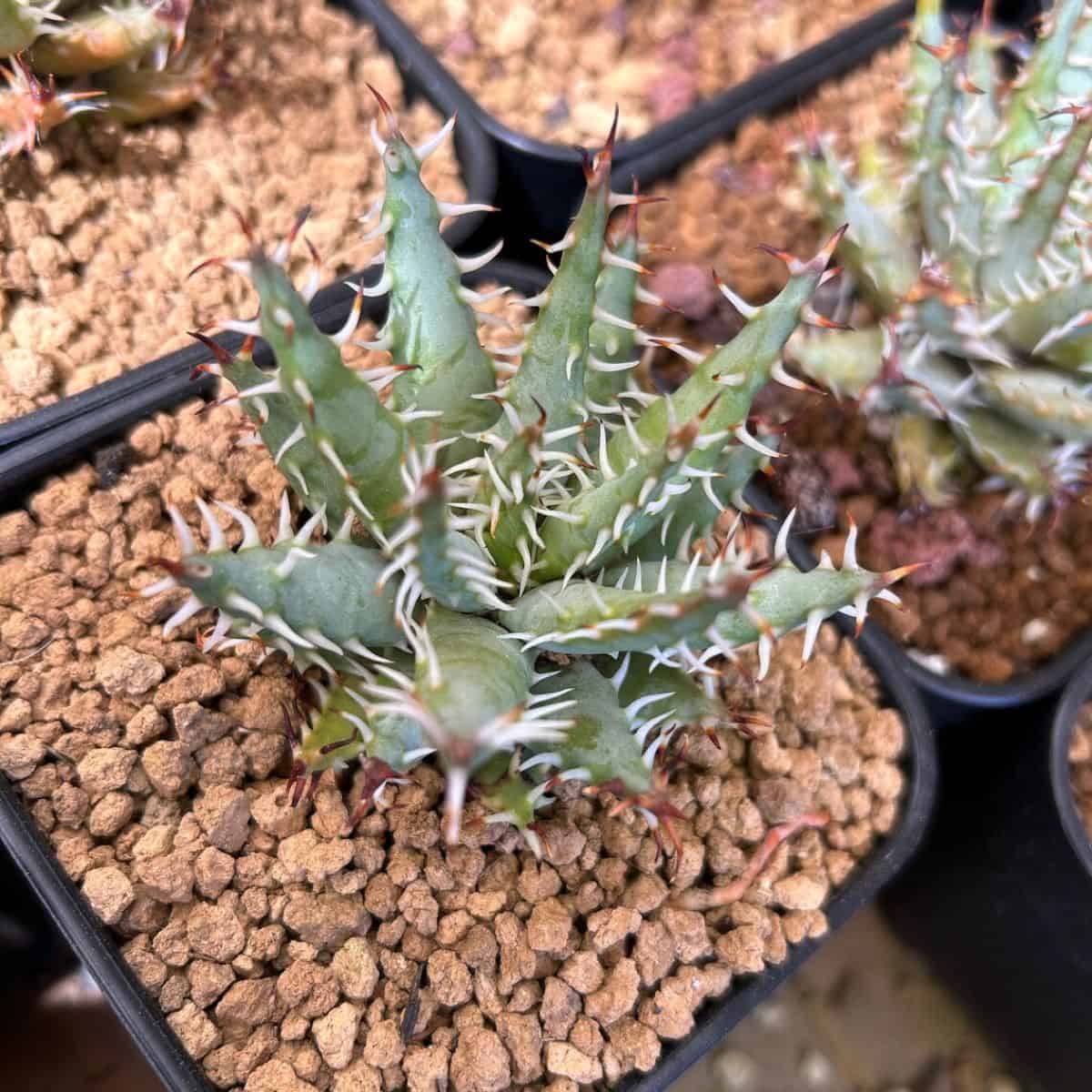
Buy it from:
| Maximum Height: | Thick but narrow triangular leaves. White teeth on the margins at the base and along the keel that turn black towards the tip of the leaves |
| Maximum Width: | Up to 12 inches |
| Watering Needs: | Weekly in dry areas, bi-weekly in most other environments |
| Soil Needs: | Gritty soil mix |
| Light Needs: | Full sun, watch for sunburn (leaves turning brown/wilting) |
| Hardiness Zone(s): | Zone 8 and up |
| Leaf Type: | Tubular and red on a 3-foot blooming stalk; flowers will fade to a reddish-orange. |
| Bloom Type: | Tubular and red on a 3-foot blooming stalk; flowers will fade to a reddish-orange. |
| Growth Type: | Clumps in the wild but not often when grown in captivity |
In its native habitat, it is called Goree, and it is another species that clumps in the wild. Rather than form wide carpets, this species will grow taller in clumps. While in captivity, it is more difficult for this species to demonstrate its normal characteristics. Flowers are only produced once the plant is 25 years old, and it is considered the slowest-growing aloe.
14. Aloe divaricata
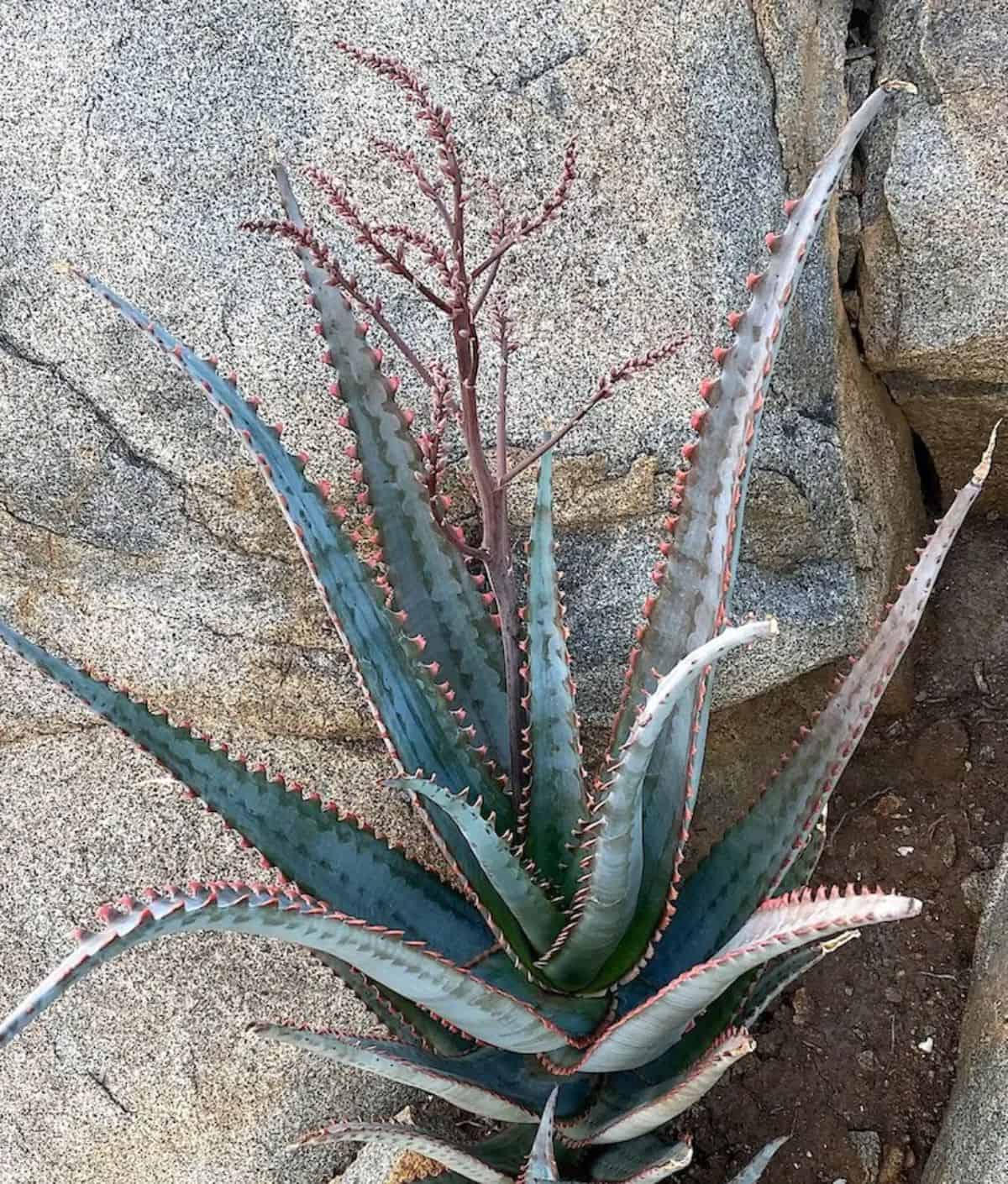
Buy it from:
| Maximum Height: | Up to 8 feet |
| Maximum Width: | Up to 4 feet |
| Watering Needs: | Weekly in dry areas, bi-weekly in most other environments |
| Soil Needs: | Gritty soil mix |
| Light Needs: | Full sun, watch for sunburn (leaves turning brown/wilting) |
| Hardiness Zone(s): | Zone 8 and up |
| Leaf Type: | Red and tubular on branching 3-foot blooming stems |
| Bloom Type: | Red and tubular on branching 3-foot blooming stems |
| Growth Type: | Can form thickets when left alone and can also be solitary when grown in a pot |
Unlike other, more compact aloe, this species has more stems and grows upwards more dramatically than others. When left to its own devices, it can easily establish a thicket which is part of its many horticultural uses. The bloom stalks don’t split at the base but rather at the top of each stalk. The narrow blue-green leaves have showy red teeth that expertly complement the silver-green of the narrow leaves.
15. Aloe megalacantha
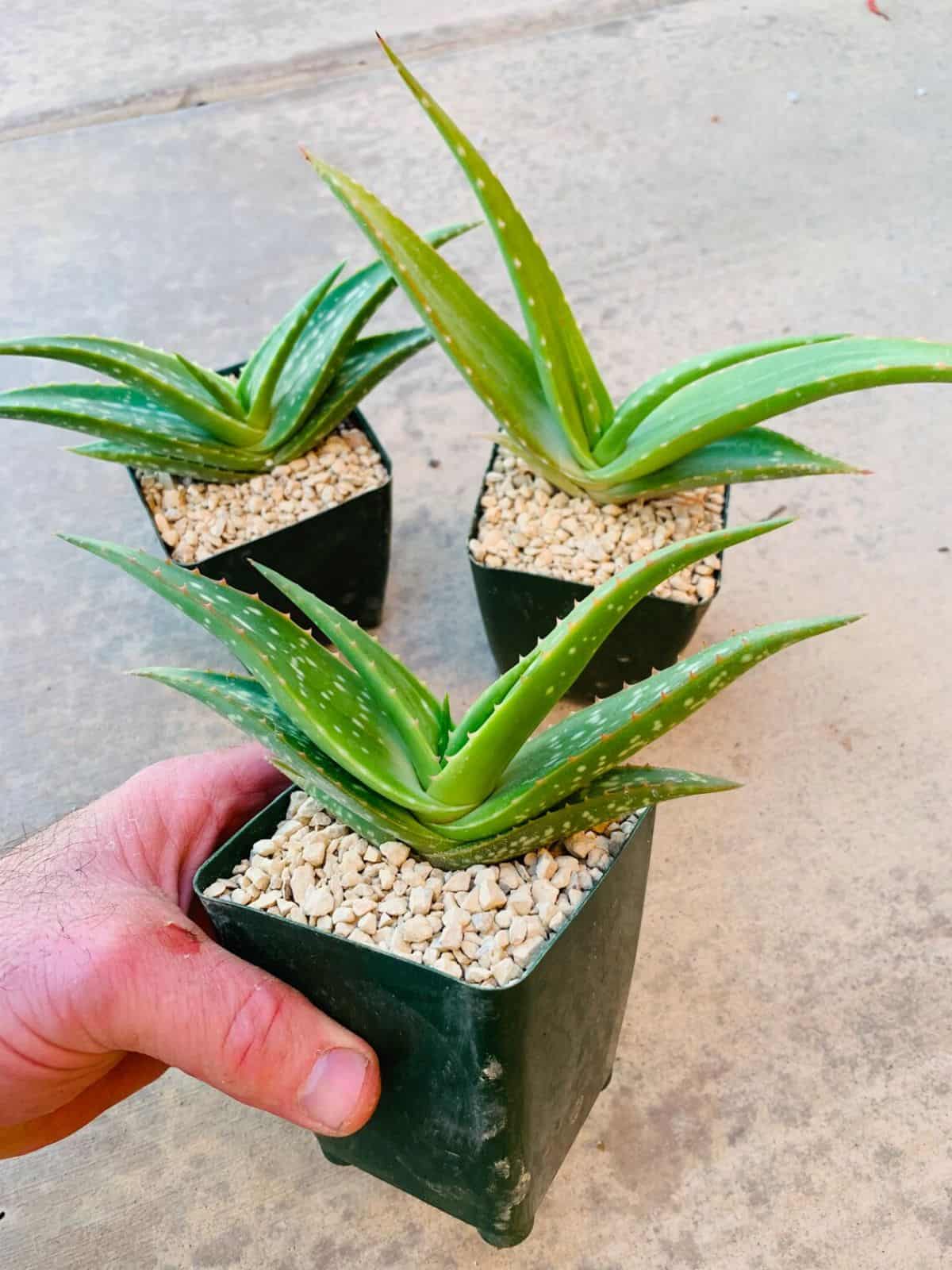
Buy it from:
| Maximum Height: | Up to 8 feet |
| Maximum Width: | Up to 5 feet |
| Watering Needs: | Weekly in dry areas, bi-weekly in most other environments |
| Soil Needs: | Gritty soil mix |
| Light Needs: | Full sun, watch for sunburn (leaves turning brown/wilting) |
| Hardiness Zone(s): | Zone 8 and up |
| Leaf Type: | Light green and triangular with a slight recurve; the teeth are very large for this plant |
| Bloom Type: | Yellow tubular flowers on 40-inch blooming stems |
| Growth Type: | Can form pups, but is mostly singular |
Named for its comparably massive teeth, A. megalacantha is a fun species to grow. It has a slight recurve to the light green leaves, and the teeth aren’t the only things that are large about this species. Compared to the ratio of blooming stalk to aloe size, this stalk comes in at a whopping 40 inches. Seems like most things with this aloe are oversized!
16. Aloe suzannae
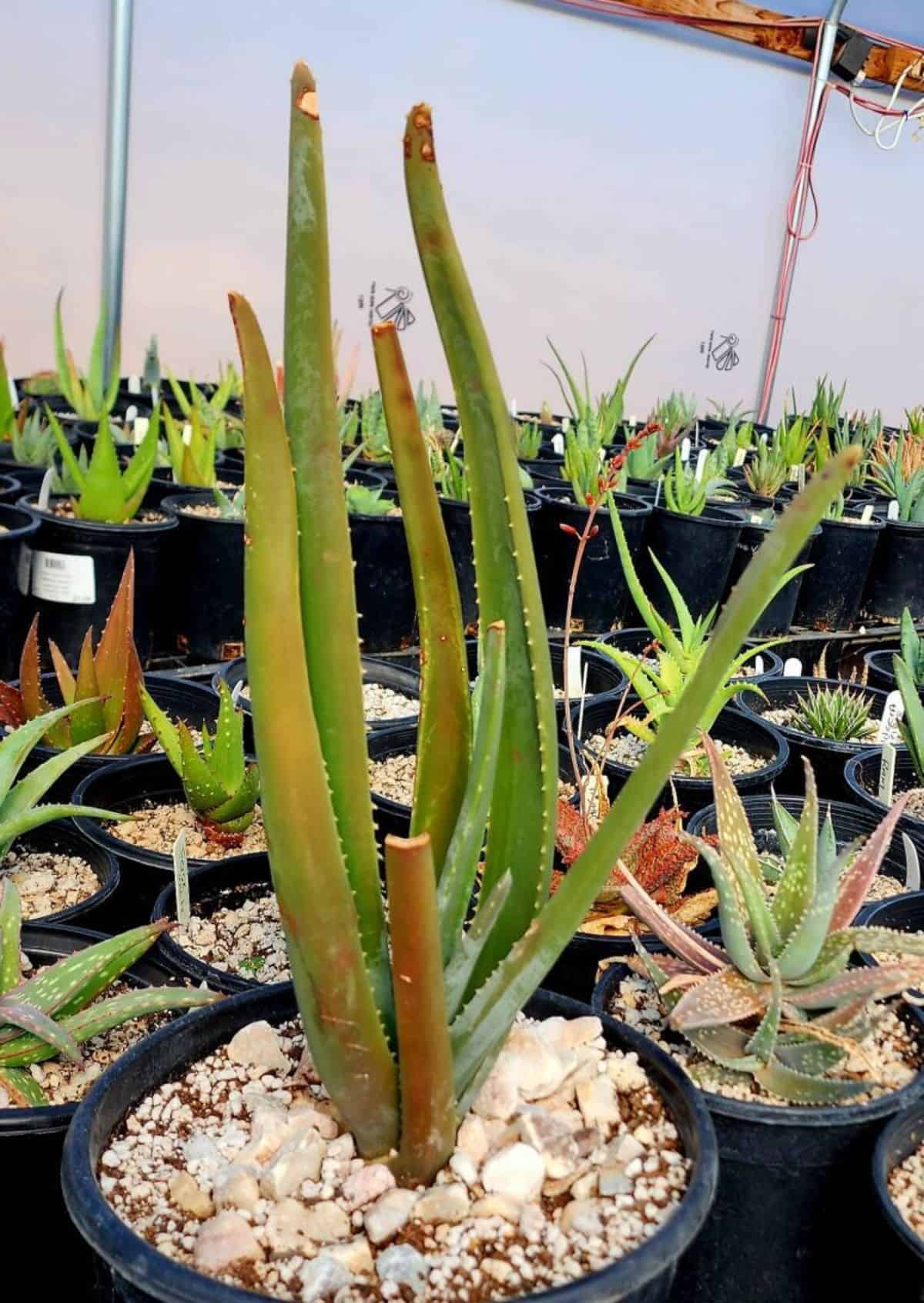
Buy it from:
| Maximum Height: | Up to 12 feet |
| Maximum Width: | Up to 5 feet |
| Watering Needs: | Weekly in dry areas, bi-weekly in most other environments |
| Soil Needs: | Gritty soil mix |
| Light Needs: | Full sun, watch for sunburn (leaves turning brown/wilting) |
| Hardiness Zone(s): | Zone 9 and up |
| Leaf Type: | Thick triangular leaves that curve upwards and can curve inwards as well. Fairly smooth leaves. |
| Bloom Type: | Bell-shaped red flowers |
| Growth Type: | Tree-like aloe |
The Malagasy Tree Aloe is a rarity amongst the genus because it is one of the few that has bell-shaped flowers rather than tubular flowers. The leaves are interesting as well because, instead of remaining flat, they curve tightly upward, but the leaves also curl inward on themselves, which resembles a more cylindrical leaf.
17. Aloe ‘Christmas Carol’
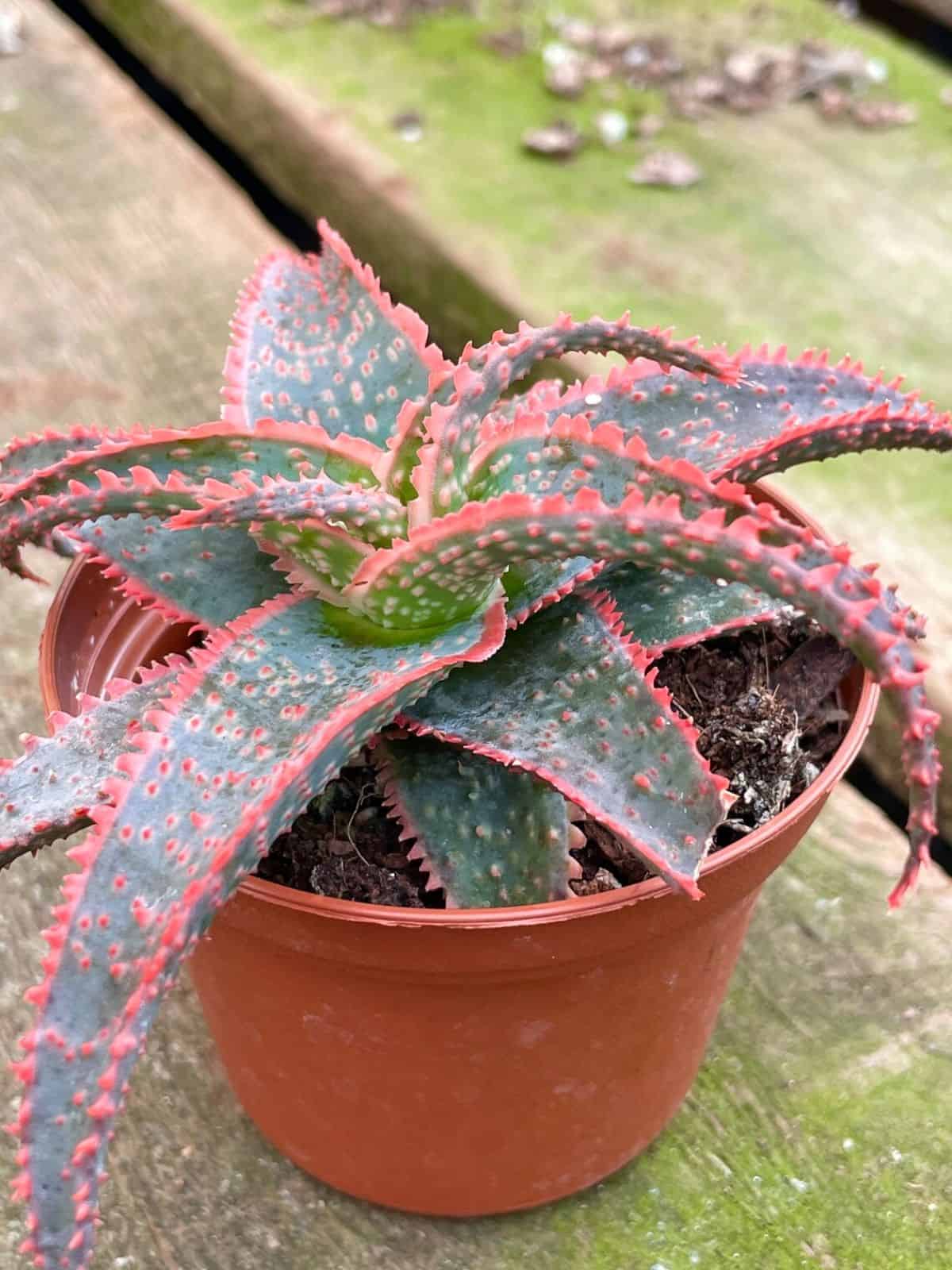
Buy it from:
| Maximum Height: | Up to one foot |
| Maximum Width: | Up to one foot |
| Watering Needs: | Weekly in dry areas, bi-weekly in most other environments |
| Soil Needs: | Gritty soil mix |
| Light Needs: | Full sun, watch for sunburn (leaves turning brown/wilting) |
| Hardiness Zone(s): | Zone 9 and up |
| Leaf Type: | Triangular and light green that fades to a deep reddish purple. Margins, teeth, and raised tubercles are red. |
| Bloom Type: | Tubular and orange |
| Growth Type: | Will clump, but slow-growing |
A species that I hope to get this holiday season is definitely the Christmas Carol. The light green of the leaves and deep red of the teeth, margins, and tubercles make it look like an aloe version of a Christmas tree. It’s another slow-growing species, but it will clump over many years.
18. Aloe humilis
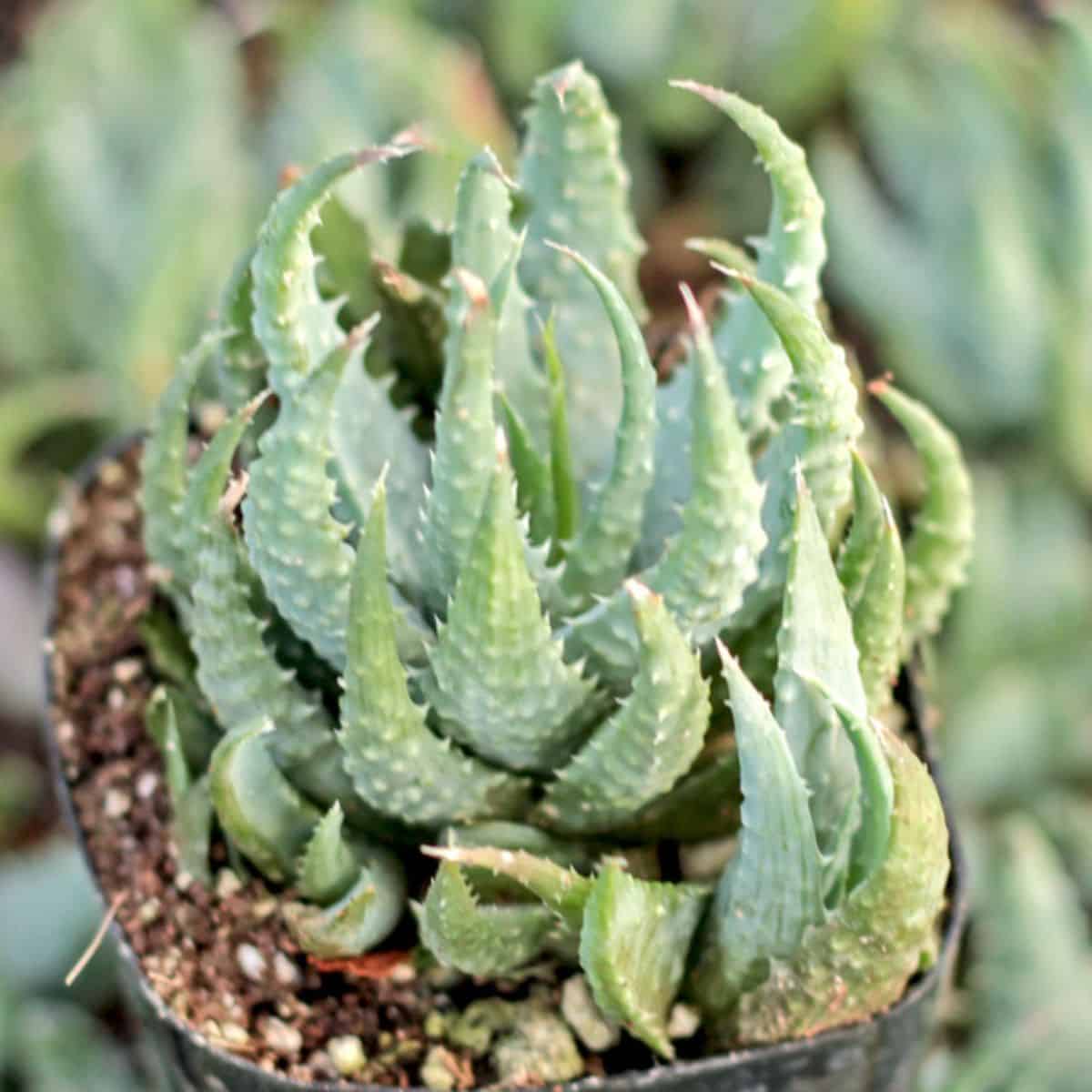
Buy it from:
| Maximum Height: | Up to 5 inches |
| Maximum Width: | Up to 8 inches |
| Watering Needs: | Weekly in dry areas, bi-weekly in most other environments |
| Soil Needs: | Gritty soil mix |
| Light Needs: | Full sun, watch for sunburn (leaves turning brown/wilting) |
| Hardiness Zone(s): | Zone 9 and up |
| Leaf Type: | Red-orange and tubular on a 14-inch blooming spike |
| Bloom Type: | Red-orange and tubular on a 14-inch blooming spike |
| Growth Type: | Dense clusters that rarely have stems |
Spider Aloe is such an interesting species! It is also sometimes referred to as a Zebra plant; however, that’s another discussion for another time. The leaves grow upward rather than outward, and the tubercles along the back of the leaves are generally random and can be linear at times.
19. Aloe haworthioides
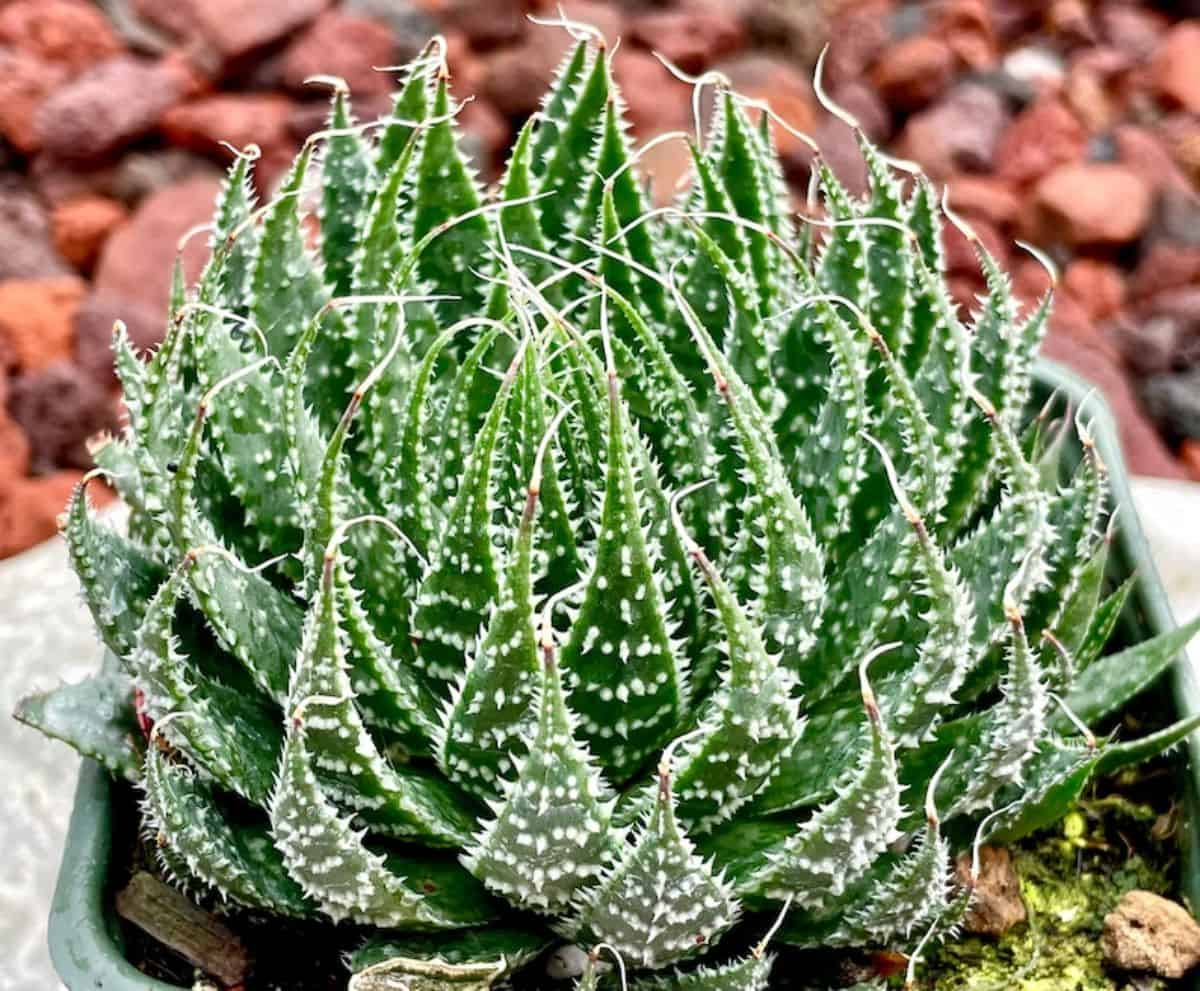
Buy it from:
| Maximum Height: | Up to 2 inches |
| Maximum Width: | Up to 2 inches |
| Watering Needs: | Weekly in dry areas, bi-weekly in most other environments |
| Soil Needs: | Gritty soil mix |
| Light Needs: | Full sun, watch for sunburn (leaves turning brown/wilting) |
| Hardiness Zone(s): | Zone 9 and up |
| Leaf Type: | Lance-shaped, dark green, and covered with very soft white teeth. |
| Bloom Type: | Tubular orange flowers on a 12-inch blooming stalk |
| Growth Type: | Clumps easily |
One of the more unique species in the aloe genus, this heavily clumping species has some of the most interesting teeth compared to other aloe. The leaves are lance-shaped, which means that they are wider and more round at the base before tapering off. White, flexible, and rather long teeth cover the entirety of the plant, which adds to its striking visual nature.
20. Aloe cameronii
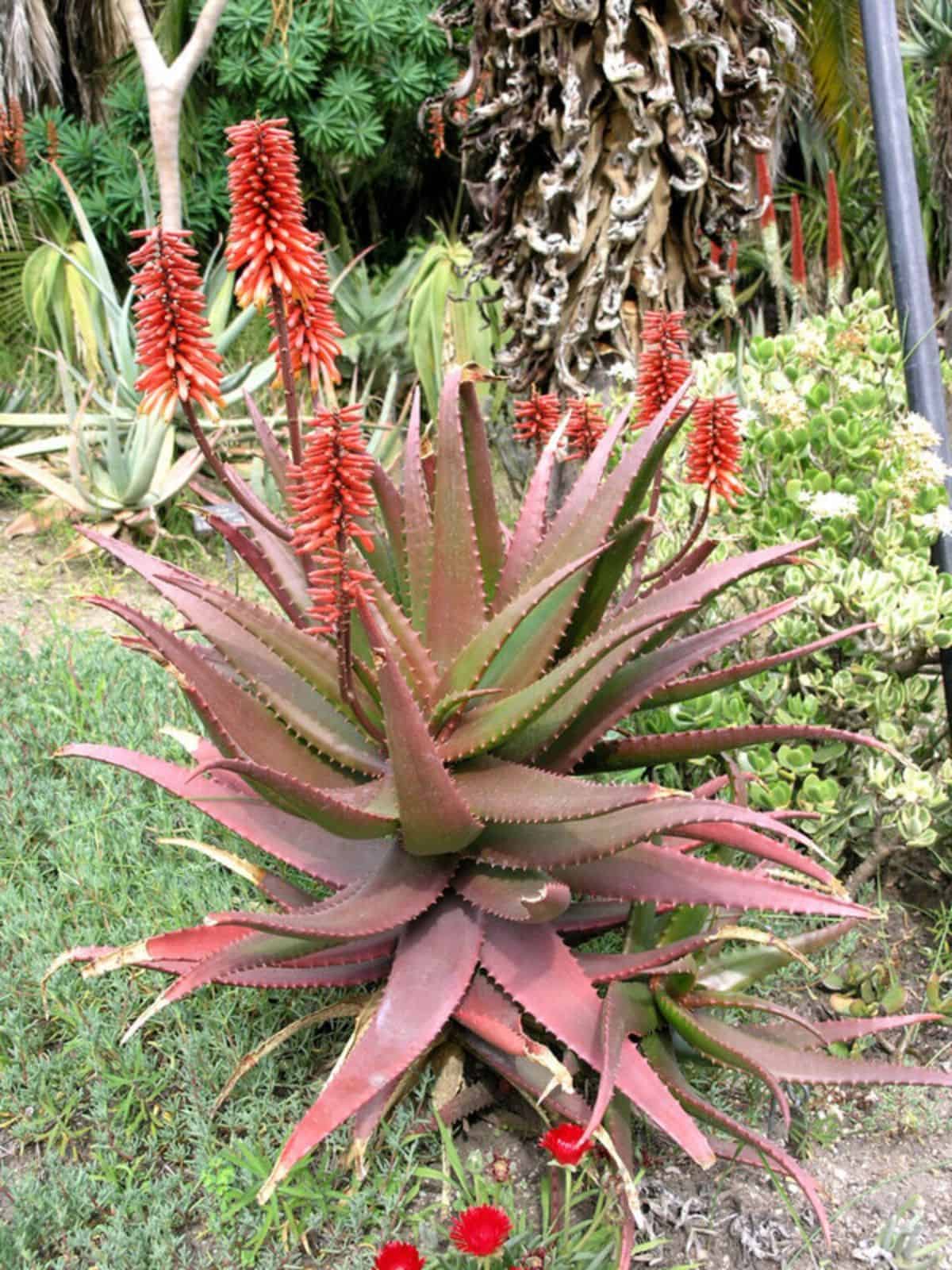
Buy it from:
| Maximum Height: | Up to 2 feet |
| Maximum Width: | Up to 4 feet |
| Watering Needs: | Weekly in dry areas, bi-weekly in most other environments |
| Soil Needs: | Gritty soil mix |
| Light Needs: | Full sun, watch for sunburn (leaves turning brown/wilting) |
| Hardiness Zone(s): | Zone 8 and up |
| Leaf Type: | Reddish maroon with teeth of the same color. Wide base triangular leaves that will stay light green if overwatered. |
| Bloom Type: | Red tubular flowers that grow on one-foot spikes |
| Growth Type: | Offsets with suckers |
Cameron's Ruwari Aloe, or Red Aloe, is one of the few species of aloe that is red while in its natural habitat and environmental conditions. When grown in controlled conditions like a greenhouse, Red Aloe will instead remain light green. This will also occur if it is grown outside and watered like a regular flowering plant instead of a succulent.
21. Aloe reitzii
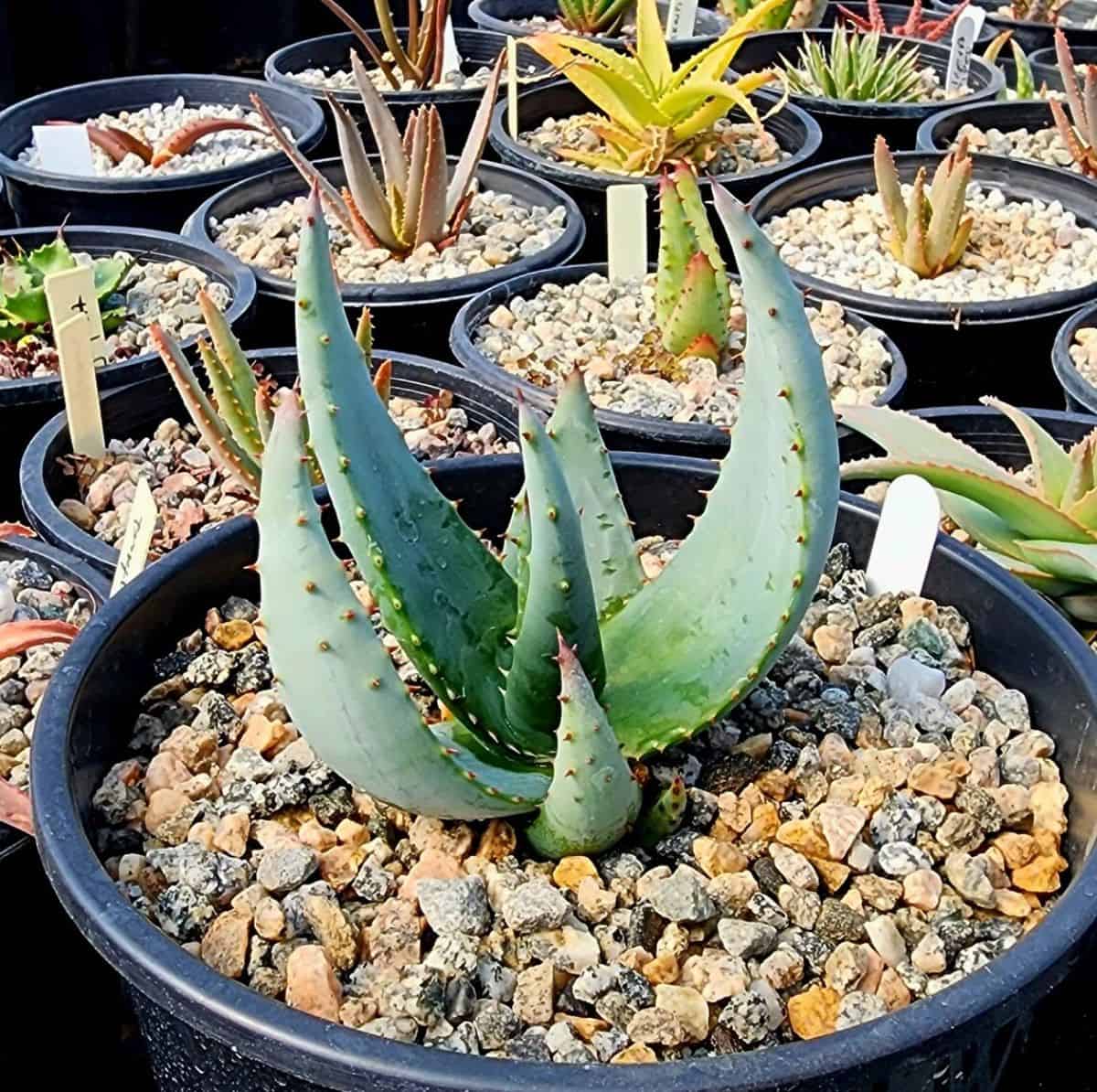
Buy it from:
| Maximum Height: | Up to 3 feet |
| Maximum Width: | Up to 4 feet |
| Watering Needs: | Weekly in dry areas, bi-weekly in most other environments |
| Soil Needs: | Gritty soil mix |
| Light Needs: | Full sun, watch for sunburn (leaves turning brown/wilting) |
| Hardiness Zone(s): | Zone 8 and up |
| Leaf Type: | Broad base that curves slightly inward. Blue-green color with reddish teeth. |
| Bloom Type: | Red tubular flowers that fade to yellow as they age |
| Growth Type: | Stemless with a single rosette |
Not to be confused with A. ferox, A. reitzii has a shorter, non-branching bloom stalk with candelabra like blooms. It looks similar to a torch as the blooms age since the older ones fade to a lighter yellow. Don’t expect these fabulous blooms right away, though: it takes seven years for this species to establish itself and bloom!
22. Aloe buhrii
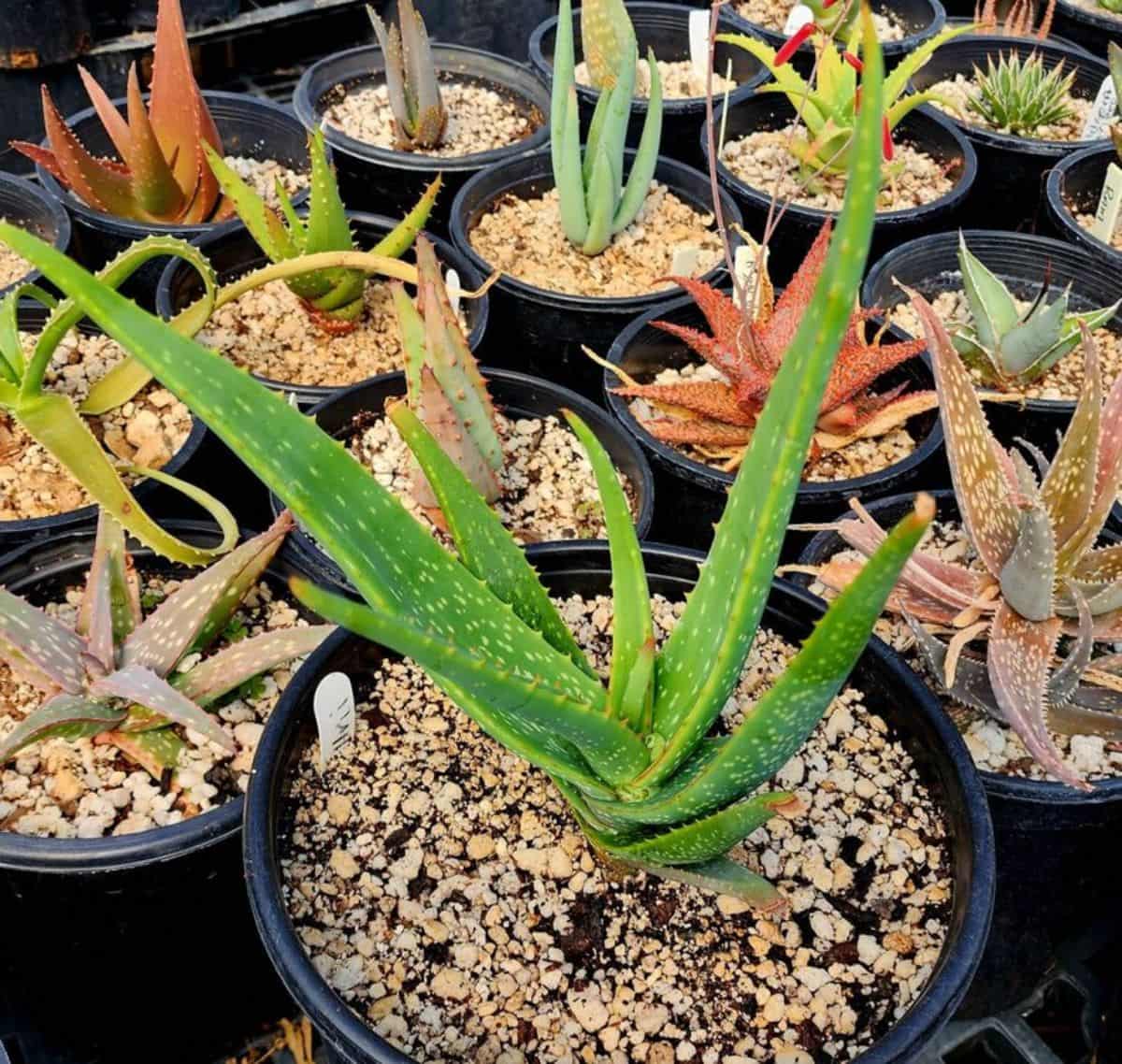
Buy it from:
| Maximum Height: | Up to 2 feet |
| Maximum Width: | Up to 3 feet |
| Watering Needs: | Weekly in dry areas, bi-weekly in most other environments |
| Soil Needs: | Gritty soil mix |
| Light Needs: | Full sun, watch for sunburn (leaves turning brown/wilting) |
| Hardiness Zone(s): | Zone 9 and up |
| Leaf Type: | Thick succulent leaves that tend to be more linear and curved towards the tip, has ‘h’ shaped spots, will turn red in harsh climates |
| Bloom Type: | Bright orange and tubular on terminally branched blooming stalks |
| Growth Type: | Solitary rosette |
Elias Buhr's Aloe is a fun species to collect because the markings along the leaves are very unique. Many of them are shaped like small ‘H’s, and they will also turn more of a reddish color in intense environments. Unlike many other aloe species, A. buhrii has orange flowers instead of the traditional reds and yellows. The blooming stalks also terminally branch rather than branch at the base.
23. Aloe ‘Hercules’
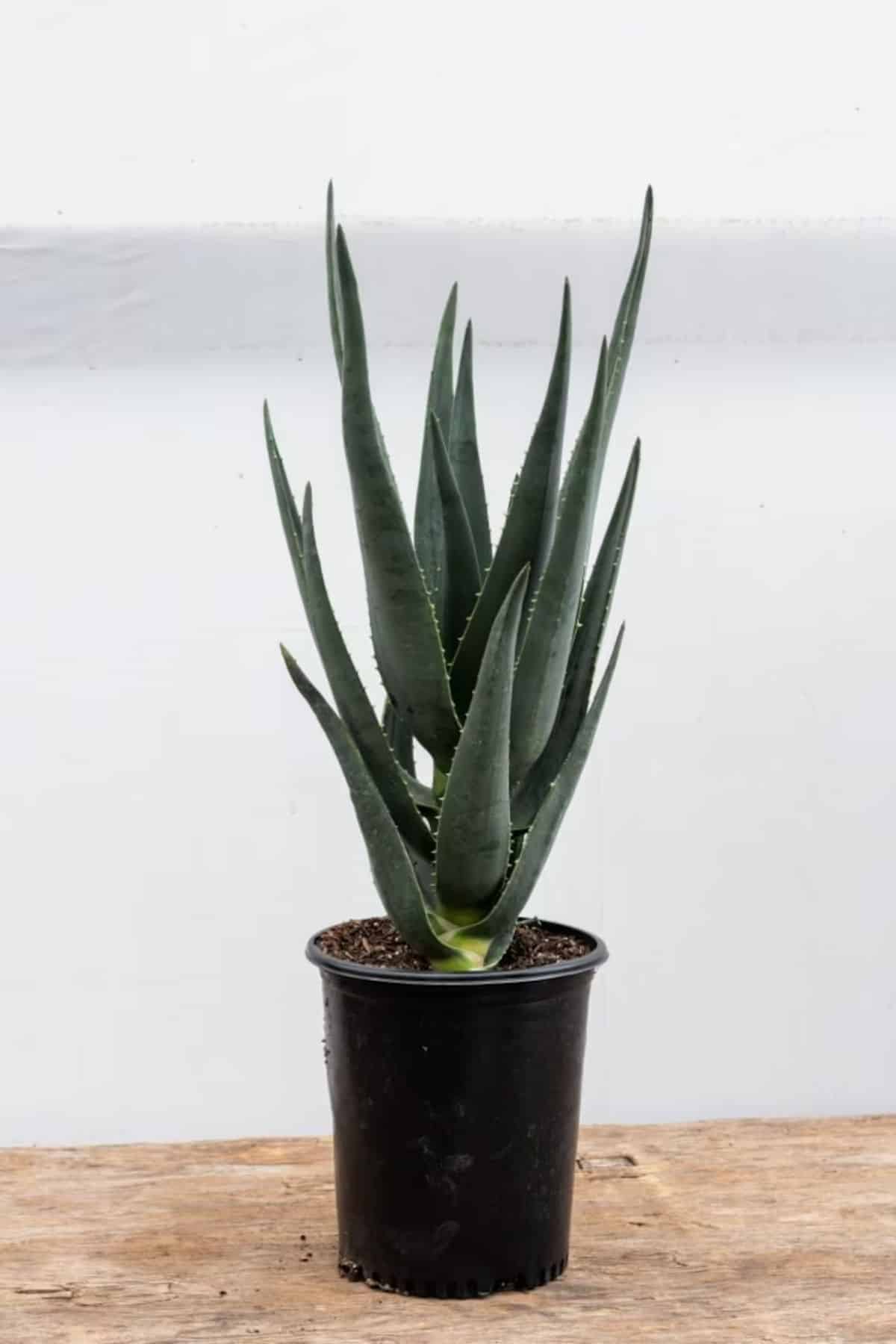
Buy it from:
| Maximum Height: | Up to 40 feet |
| Maximum Width: | Up to 20 feet |
| Watering Needs: | Weekly in dry areas, bi-weekly in most other environments |
| Soil Needs: | Gritty soil mix |
| Light Needs: | Full sun, watch for sunburn (leaves turning brown/wilting) |
| Hardiness Zone(s): | Zone 9 and up |
| Leaf Type: | Large dark green and triangular leaves. |
| Bloom Type: | Pink and tubular with green tips |
| Growth Type: | Tree-like with terminal rosettes |
Don’t start singing the song just yet. Hercules is an interesting cross between the large Tree Aloe, Aloe barberae (A. bainesii), and the smaller Quiver Tree, Aloe dichotoma. Crossing the two yielded a very unique appearance: rather than smaller terminal rosettes, this tree, when full-grown, has massive rosettes that are known for breaking the branches. Not only that, it has one of the rarest colors of flowers: green and pink.
24. Aloe aristata
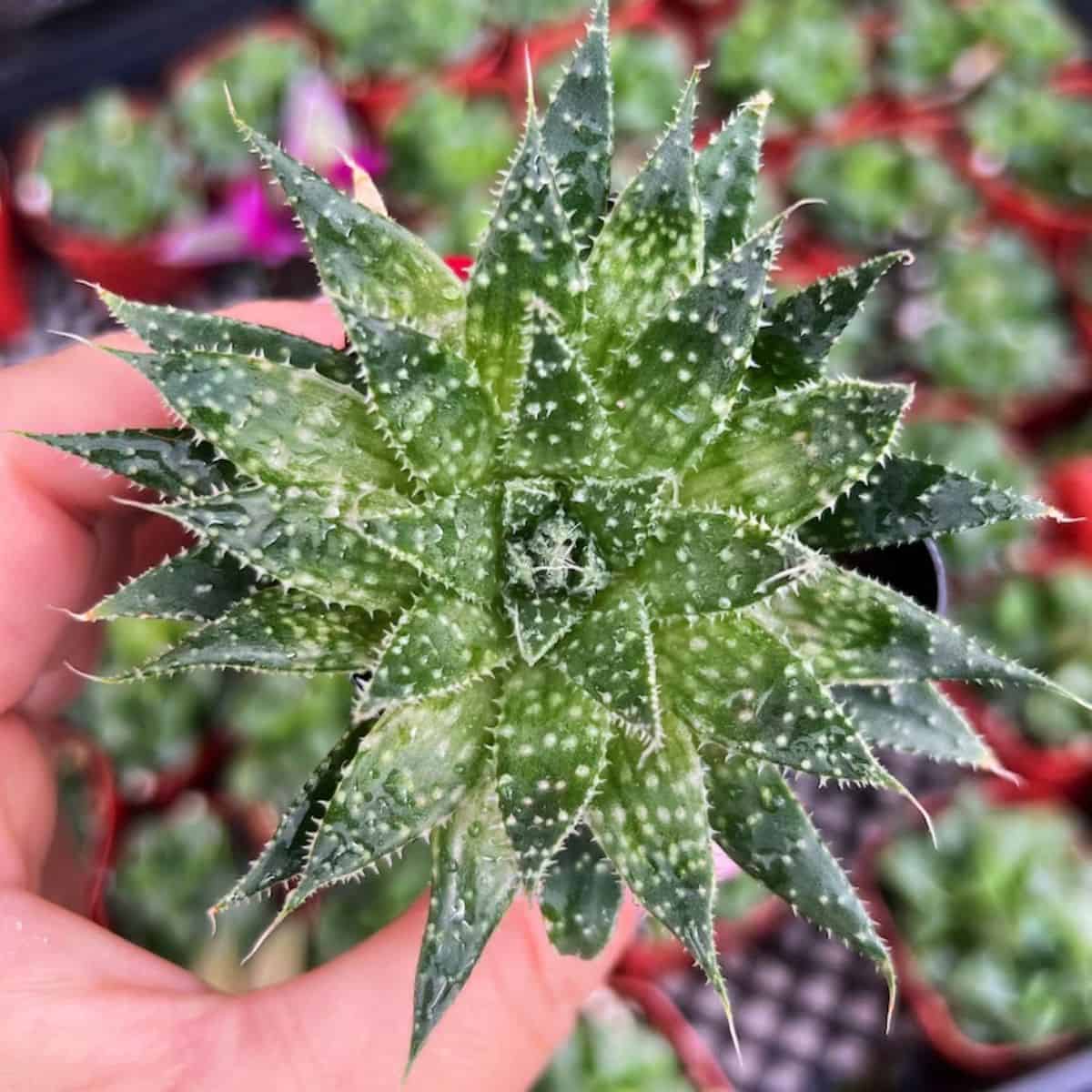
Buy it from:
| Maximum Height: | Up to 8 inches |
| Maximum Width: | Up to 8 inches |
| Watering Needs: | Weekly in dry areas, bi-weekly in most other environments |
| Soil Needs: | Gritty soil mix |
| Light Needs: | Full sun, watch for sunburn (leaves turning brown/wilting) |
| Hardiness Zone(s): | Zone 8 and up |
| Leaf Type: | Dark green triangular leaves with lacy, malleable teeth. |
| Bloom Type: | Orange-red and tubular on 20-inch tall blooming stalks |
| Growth Type: | Clumping rosettes |
Lace Aloe is named that way because of the teeth that can be oddly elongated. The crisscrossing of the hairs on the teeth gives it the appearance of lace that crawls along and connects the leaves. Like many other species, the leaves are dark and triangular, with orange-red flowers that sprout from the center.

